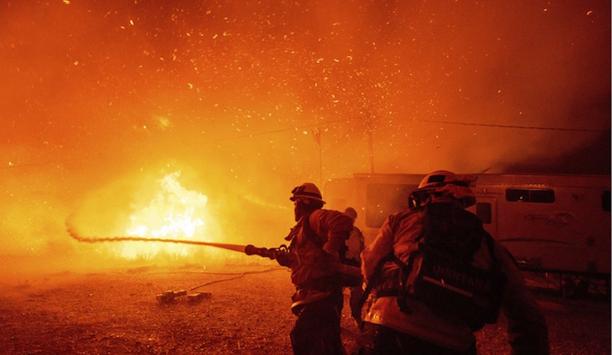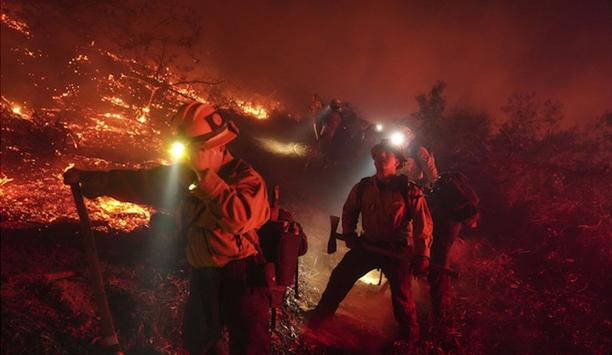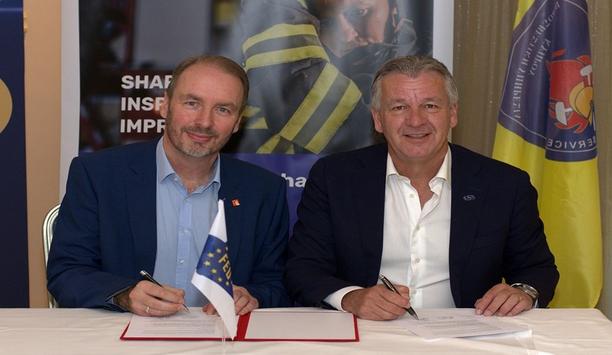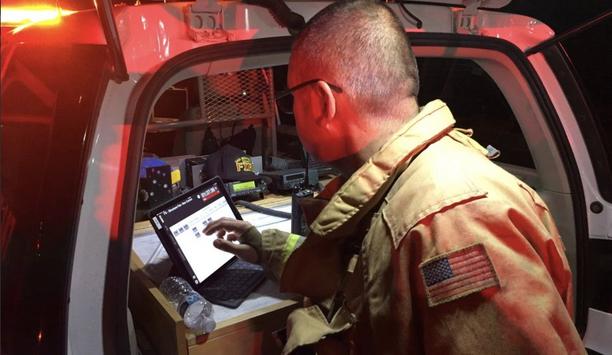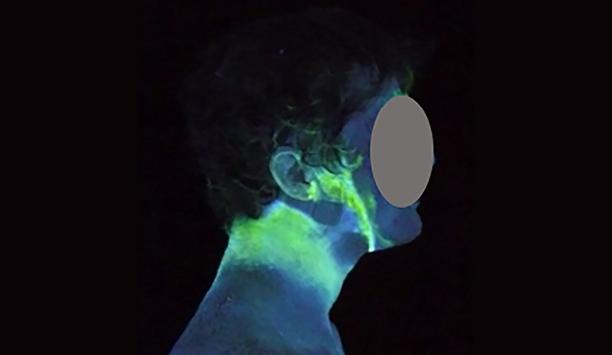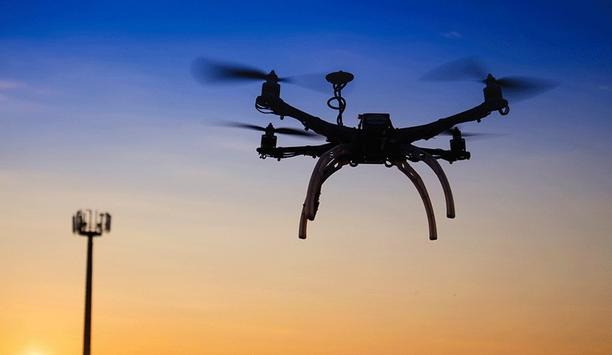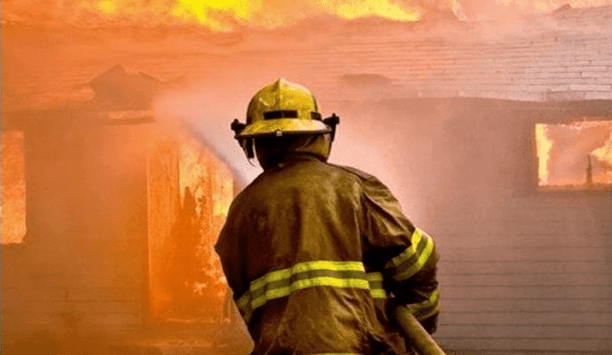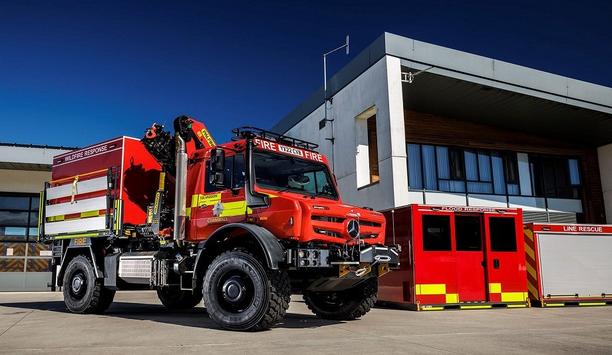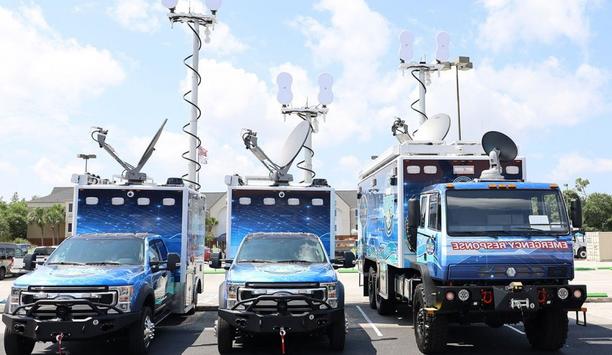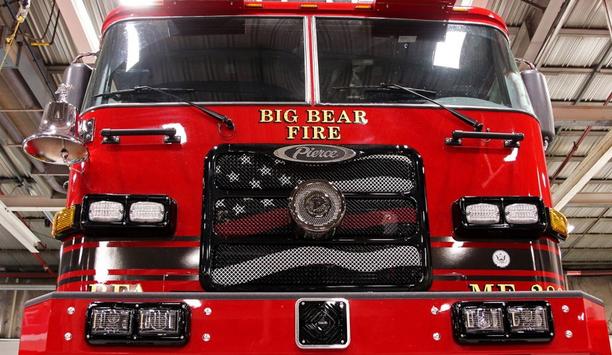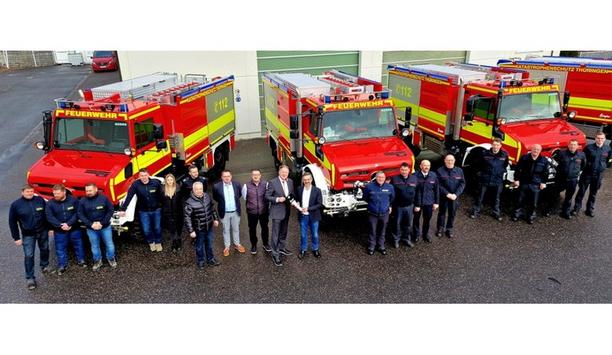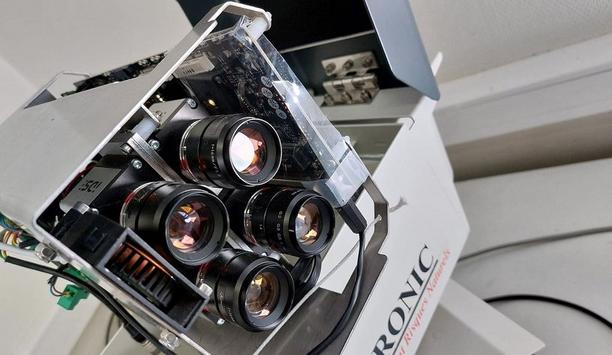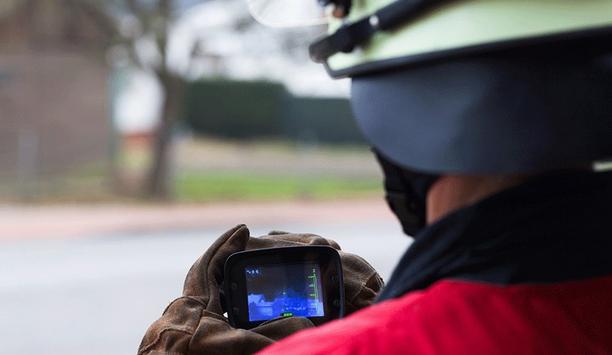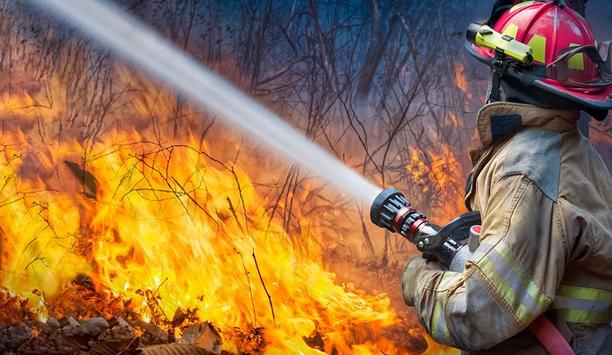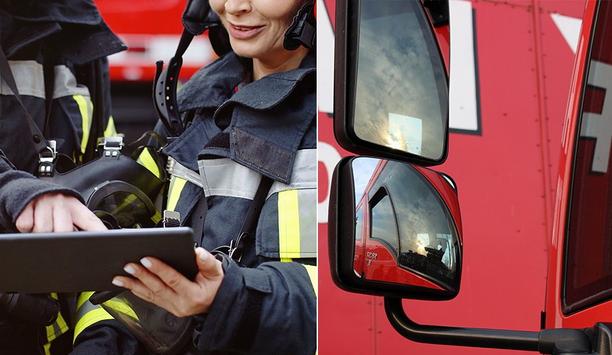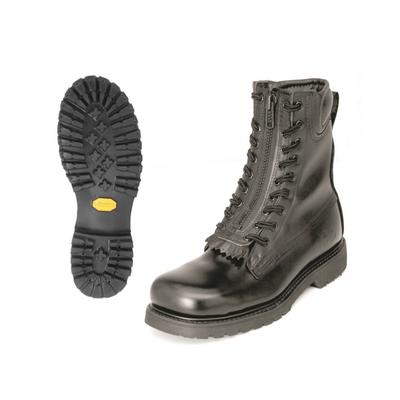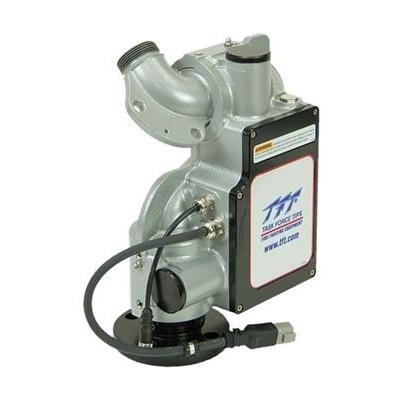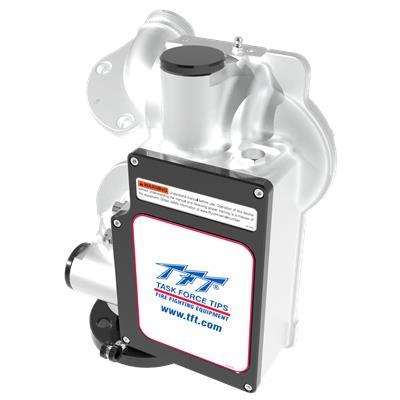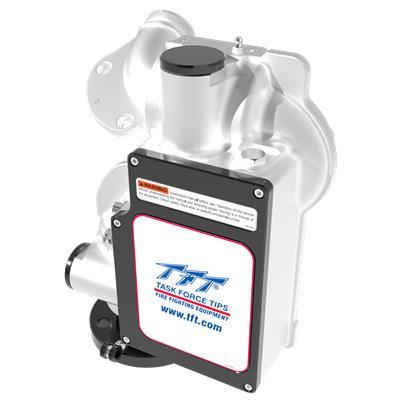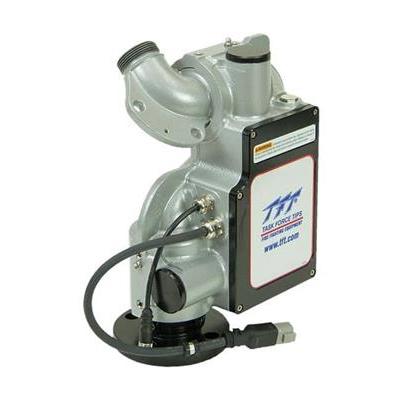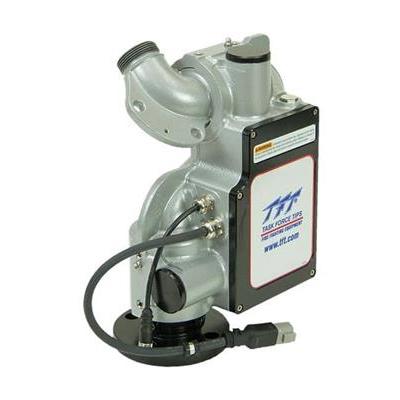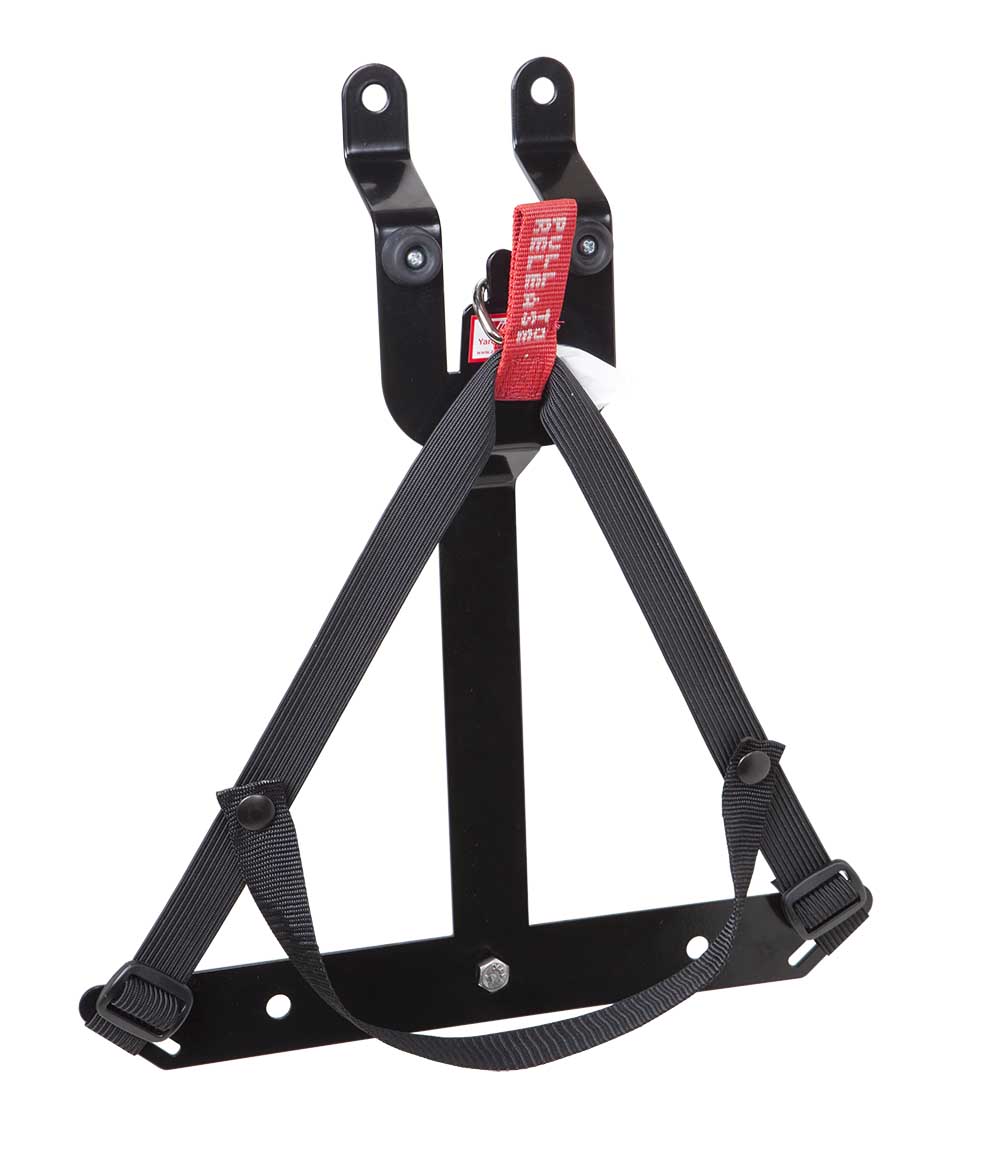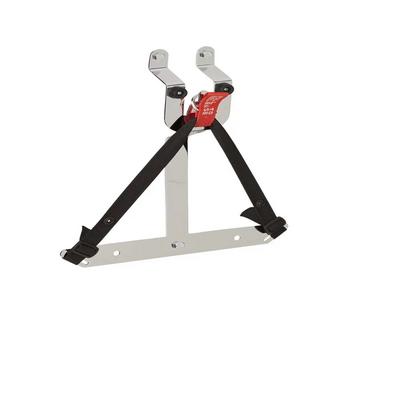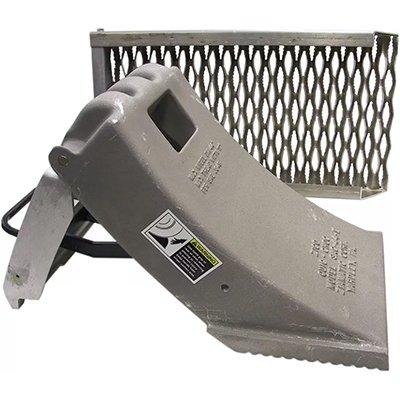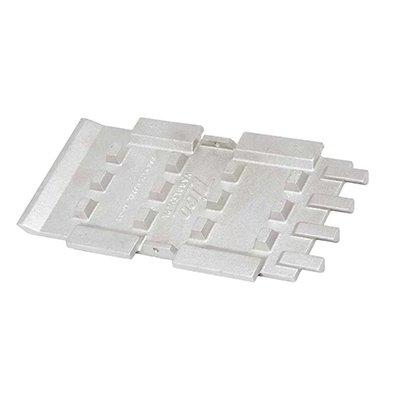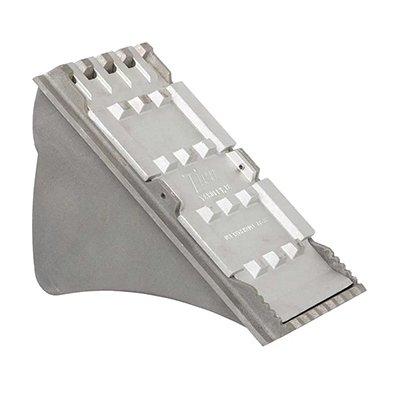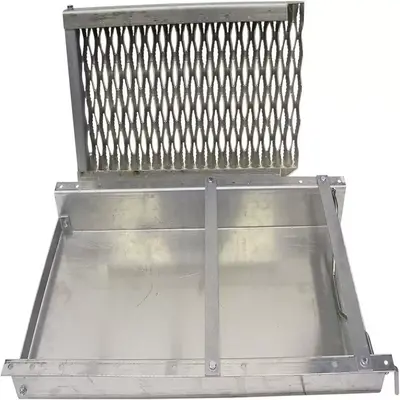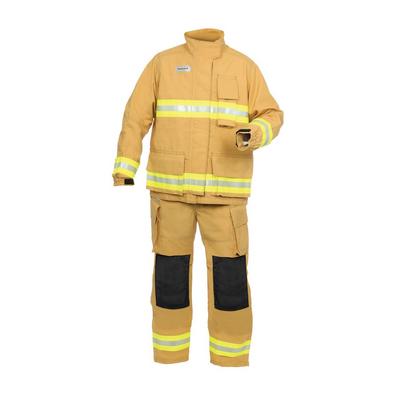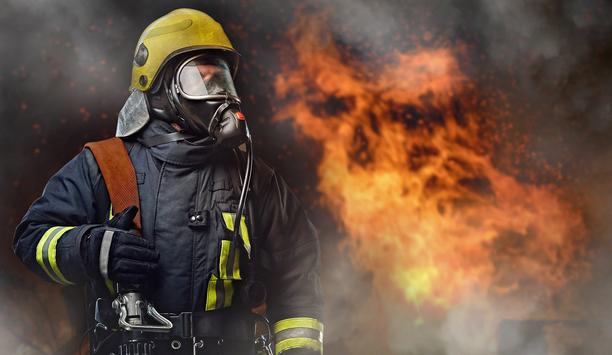Wildfires
Rosenbauer America, a pioneering manufacturer of fire apparatus and firefighting equipment, will be showcasing its latest advancements in technology at FDIC International 2025 in Indianapolis, IN. Attendees are invited to visit Rosenbauer's indoor exhibit (booth #3413) at the Indiana Convention Center (ICC) and the outdoor demonstration area on South Street to experience firsthand the company's commitment to unmatched operational performance and firefighter safety. Featured Fire Apparatus Ros...
Elite Interactive Solutions, a remote video guarding pioneer using proprietary intelligence and integration to achieve proven crime prevention, announces the company and its many California customers safely made it through the wildfire disaster. With its headquarters and Security Operations Command Center (SOCC) located in the heart of Downtown Los Angeles, Elite remained on high alert for its operations, personnel and their families, and its many local clients during the unprecedented fire t...
Firefighters fought to maintain the upper hand on a huge and rapidly moving wildfire that swept through rugged mountains north of Los Angeles and resulted in more than 50,000 people being put under evacuation orders or warnings. The Hughes Fire broke out late Wednesday morning and, in less than a day, had charred nearly 16 square miles (41 square kilometers) of trees and brush near Castaic Lake, a popular recreation area about 40 miles (64 kilometers) from the devastating Eaton and Palisades...
Winds picked up on Tuesday in Southern California and at least a couple of new wildfires broke out as firefighters remained on alert in extreme fire weather two weeks after two major blazes started that are still burning in the Los Angeles area. Gusts could peak at 70 mph (113 kph) along the coast and 100 mph (160 kph) in the mountains and foothills during extreme fire weather that is expected to last through Tuesday morning. Ripe for explosive fire growth Wind speeds ra...
Facing mounting questions over a chaotic evacuation, top L.A. County officials say they want to build a database of residents with disabilities who require help fleeing a neighborhood engulfed in flames. L.A. County Fire Chief Anthony Marrone told county supervisors at a public meeting Tuesday that the ongoing wildfires underscored the need for a “database to track people who have mobility challenges or health challenges.” “Trying to do it during an emergency is very, v...
The water system used to fight the Palisades fire in Los Angeles buckled under the demands of what turned out to be the most destructive fire in city history, with some hydrants running dry as they were overstressed without assistance from firefighting aircraft for hours early Wednesday. The Los Angeles Department of Water and Power was pumping from aqueducts and groundwater into the system, but demand was so high that it wasn’t enough to refill three 1-million gallon tanks in hilly Pac...
News
In 2026, INTERSCHUTZ in Hannover will feature an exciting addition to its program: on June 3 and 4, 2026, around 300 international chief fire officers and strategic pioneers in the fire service will come together at the trade fair for the premiere of the 'FEU Leadership Conference'. To formalize this collaboration, the FEU and INTERSCHUTZ signed a joint Memorandum of Understanding (MOU) at the 56th FEU Council meeting in Limassol, Cyprus, on November 8, 2024. Best practices The FEU is a strong network of European fire officers associations and national fire departments The FEU is a strong network of European fire officers associations and national fire departments, dedicated to connecting full-time fire and rescue service personnel across Europe. It facilitates the exchange of best practices and collaborates on initiatives and projects aimed at enhancing public safety throughout Europe. Public safety "Our commitment to public safety and resilience is strengthened by our shared dedication. Leadership is a cornerstone in shaping our future, and through this partnership, we’re moving closer to that goal," says Stephan Wevers, FEU President. Stephan Wevers adds, "Together at INTERSCHUTZ 2026, we look forward to connecting, learning, and building a safer Europe and beyond." FEU Leadership Conference for INTERSCHUTZ 2026 "We are delighted to have secured the FEU Leadership Conference for INTERSCHUTZ 2026. Welcoming around 300 international chief fire officers and strategic pioneers from across Europe is an absolute highlight for us and our exhibitors, visitors, and partners," says Bernd Heinold, Project Director of INTERSCHUTZ at Deutsche Messe AG. Bernd Heinold adds, "Networking, learning, exchanging ideas, discussing current and future challenges, and finding solutions together are at the heart of INTERSCHUTZ. Having FEU 2026 join this network is a tremendous signal for the global blue light community."
On Friday, September 13, 2024, Hawaiʻi Attorney General Anne Lopez announced the results of the Lahaina Fire Incident Analysis Report, the second report of the three-part evidence-based investigation into how state and county governments responded during the Maui wildfires. The report revealed that a complex set of factors including weather and its impacts, risk and preparedness, decades-old infrastructure, organizational structure, and incident management and coordination created a historic disaster. The report was prepared by the Fire Safety Research Institute (FSRI), a part of UL Research Institutes. wake-up call “This investigation serves as a wake-up call for the state and county governments to learn from the past and urgently prepare for the future,” says Attorney General Lopez. “It is also a testament to the courage of our emergency services personnel and the everyday heroes who helped thousands of Lahaina residents and visitors to reach safety.” This was the most deadly fire in North America in 100 years. third-party FSRI FSRI has extensive experience researching fire dynamics, structure-to-structure fire spread In August 2023, Attorney General Lopez selected the independent, third-party FSRI to assess the performance of state and county agencies in preparing for and responding to the Maui wildfires. FSRI has extensive experience researching fire dynamics, structure-to-structure fire spread, and near-miss firefighting incidents. wildfire preparedness “The wildfire preparedness, prevention, and operational measures in place that day faced significant—sometimes unprecedented—challenges as the threat escalated. Insufficient resources and investment across multiple domains hindered the development of a unified fire management strategy and impacted prevention, preparedness, and response,” said Steve Kerber, Ph.D., PE, vice president and executive director of FSRI. “The report concludes the devastation caused by the Lahaina fire cannot be connected to one specific organization, individual, action, or event,” added Kerber. “The conditions that made this tragedy possible were years in the making.” systems-analysis methodology The report emphasizes the crucial role multiple entities should play in directly implementing these recommendations For this research, FSRI used a systems-analysis methodology to evaluate the complex intersections between environmental conditions, human activity, established policies and procedures, organizational structures, and accepted norms and perceptions. FSRI made 84 findings with 140 recommendations to address these issues. The report emphasizes the crucial role multiple entities such as agencies, and state and county governments should play in directly implementing these recommendations. Phase Two report findings The Phase Two report identified three areas that need immediate attention: Perception of Risk and PreparednessThe low perception of wildfire risk is not aligned with the growing wildfire threat in Hawaiʻi, which led to a widespread lack of preparedness among county, state, and privately owned entities and residents. This also includes systemic issues tied to years of decisions that have led to underinvestment in wildfire prevention and mitigation policies, public education, and organizational structure. Infrastructure Standards Decades-old infrastructure standards, including community planning, codes and standards, public utilities, and vegetation management, were key contributors to the widespread fire destruction in Lahaina. Lahaina’s dense urban layout turned tragic as the fire’s initial impact hit the most populated area, rapidly spreading through closely packed structures and creating severe evacuation obstacles. Incident Management and Coordination First responders heroically saved many lives, placing themselves in extreme danger between the unpredictable fire fronts and vulnerable residents. The Maui County incident management operations, however, consisted of a siloed command structure that contributed to a lack of communication both to the public and responding agencies. The lack of pre-event planning, unified incident command, and operational coordination with assisting and cooperating agencies resulted in insufficient communications that impacted the ability to provide effective evacuation and firefighting operations during the wildfire event. analysis with recommendations The focus of the Phase One Lahaina Fire Comprehensive Report and timeline was to identify the facts “Our Phase Two report shows that Lahaina lacked the level of cohesive fire prevention, preparedness, management strategy, resources, and investment that are necessary to protect the population from an extreme wildfire event,” added Kerber. The focus of the Phase One Lahaina Fire Comprehensive Report and timeline was to identify the facts; the Phase Two Lahaina Fire Incident Analysis Report is the scientific analysis with recommendations that can be implemented more quickly; and Phase Three will focus on broader systemic recommendations for the future. comprehensive database Attorney General Lopez also announced the comprehensive database of documents and media obtained during the investigation is publicly available. It contains approximately 850 gigabytes of video files, audio files, photographs, and documents relating to the August 8, 2023, Maui fires obtained by the Department and FSRI in connection with this investigation. Among other files, this database contains: Maui Police Department (MPD) body camera footage and other videos of the fire event; 911 dispatch audio files; Vehicle location data for MPD and Maui Fire Department vehicles during the fire event; Notes, sign-in sheets, photographs, and other documents created within the Maui Emergency Operations Center (EOC) on August 8, 2023, and afterward; FSRI damage assessment videos and images; Audio recordings of interviews conducted by FSRI with dozens of state and county officials; and All manner of documents from state, county, and federal agencies. investigation transparency Access to this database is being provided as a public service by the Department of the Attorney General at no charge so all of the people of Hawaiʻi may learn directly from the source documents regarding this tragedy. “From the outset, our commitment to transparency in this investigation has been of crucial importance, and the release of this database honors our continuing commitment,” said Attorney General Lopez. science-based recommendations “We are not here to place blame. It is clear from the Phase Two analysis that we need to make significant changes at the county and state level and involve a broad range of individuals and organizations, to ensure we are better prepared for future wildfires that are not only possible but increasingly likely,” added Attorney General Lopez. “Good governance requires we take these science-based recommendations seriously and work together to implement changes in our processes and protocols to save lives and property and ensure Hawaiʻi is safer and has a more sustainable future for residents and visitors.”
Testing has found that a revolutionary PPE fabric, developed for wildland firefighting by Hainsworth Protective Fabrics and woven using Merino Wool, provides 17% more breathability than alternative blends. The brand’s ECO-DRY fabric was Thermal Evaporative Resistance (RET) tested by an accredited independent test house against a prototype wildland fabric made from a 100% meta-aramid blend. RET testing is a type of fabric testing that quantifies moisture vapor transfer and breathability. Better moisture management Further testing was carried out at James Heal in Halifax-using their state-of-the-art WickView equipment In RET testing, a lower value demonstrates increased moisture vapor transfer, which in this case means greater breathability. When testing was complete, ECO-DRY was found to be 17% more breathable than the prototype fabric, proving that it offers better moisture management properties than fabric made from a 100% meta-aramid blend. Further testing was carried out at James Heal in Halifax-using their state-of-the-art WickView equipment. This machine tracks and records the real-time liquid transfer through the fabric, replicating how it performs when worn. This testing found that ECO-DRY demonstrates excellent wicking properties for a flame-retardant fabric, while the comparison fabric didn’t allow any liquid to pass through. WickView testing The meta-aramid version demonstrated no wicking properties in WickView testing and had lower breathability than the standard merino wool version, resulting in overall poorer moisture management. Reduced breathability and wickability can make the wearer feel uncomfortable and put them at risk of heat exhaustion. However, with the inclusion of Merino Wool in the ECO-DRY fabric, sweat is drawn away from the firefighter’s skin and through the fabric, which helps them maintain a manageable body temperature. Frequent and severe wildfires Clothing with effective wicking effects helps to fade heat more fast and stops the wearer from overheating With wildland firefighting becoming increasingly challenging due to more frequent and severe wildfires, the need for protective clothing that can withstand extreme conditions while ensuring the wearer's comfort has never been more critical. Clothing with effective wicking properties helps to evaporate heat more quickly and stops the wearer from overheating. This breakthrough will reduce the chance of heat stress and improve firefighters' performance in the most demanding environments, improving safety and comfort. Integration of Merino Wool Martin Haworth, Hainsworth Protective Fabrics Technical Manager, explains, “ECO-DRY fabric combines the natural properties of Merino Wool with advanced flame-retardant fibers, creating a material that meets and exceeds the rigorous demands of wildland firefighting." "The integration of Merino Wool offers superior moisture management and breathability, crucial for maintaining core body temperature during intense physical activity. In addition, the fabric's ability to wick moisture away from the skin ensures that firefighters remain dry and comfortable, reducing the likelihood of heat exhaustion.” Fiber Positioning Technology Hainsworth Protective Fabrics develops and weaves cutting-edge PPE fabrics that deliver unrivaled protection, comfort and quality and surpass international standards. Using a unique process called Fiber Positioning Technology, Hainsworth PPE fabric is trusted by thousands of emergency service professionals across the globe, including firefighters, police and emergency personnel. Each fabric crafted by Hainsworth Protective Fabrics, a subsidiary of AW Hainsworth, established in 1783, is developed at a family-run heritage textile mill in West Yorkshire and tested at the company’s state-of-the-art laboratory and independently.
The water system used to fight the Palisades fire in Los Angeles buckled under the demands of what turned out to be the most destructive fire in city history, with some hydrants running dry as they were overstressed without assistance from firefighting aircraft for hours early Wednesday. The Los Angeles Department of Water and Power was pumping from aqueducts and groundwater into the system, but demand was so high that it wasn’t enough to refill three 1-million gallon tanks in hilly Pacific Palisades that help pressurize hydrants for the neighborhood. Many went dry as at least 1,000 buildings were engulfed in flames. dry hydrants The dry hydrants prompted a swirl of criticism on social media, including from President-elect Donald Trump, against Los Angeles Mayor Karen Bass and Gov. Gavin Newsom’s water management policies. But state and local officials and experts forcefully hit back, saying critics were connecting unrelated issues and spreading false information during a crisis. State water distribution choices were not behind the hydrant problems, they said, nor was a lack of overall supply in the region. protect endangered species Trump has sided with farmers over environmentalists in a long-running dispute over California’s scarce water In a post on his Truth Social media network, Trump connected it to criticism of the state’s approach to balancing the distribution of water to farms and cities with the need to protect endangered species including the Delta smelt. Trump has sided with farmers over environmentalists in a long-running dispute over California’s scarce water resources. Janisse Quiñones, head of the Los Angeles Department of Water and Power, said later at a news conference that 3 million gallons of water were available when the Palisades fire started but the demand was four times greater than “we’ve ever seen in the system.” paused firefighting efforts Hydrants are designed for fighting fires at one or two houses at a time, not hundreds, Quiñones said, and refilling the tanks also requires asking fire departments to pause firefighting efforts. Mayor Bass said 20% of hydrants went dry. “People are fleeing. People have lost their lives. Kids lost their schools. Families are completely torn asunder. Churches burned down. And this guy wanted to politicize it,” Newsom said of Trump on CNN. He contrasted the former president’s accusations with President Joe Biden standing by the devastated communities. global water sustainability Peter Gleick, senior fellow at the Pacific Institute, a nonprofit that focuses on global water sustainability, dismissed Trump’s criticism as well. “Those fights have been going on for a long time, and they have not affected in any way the water supply for firefighting in southern California,” Gleick said. About 40 percent of Los Angeles city water comes from state-controlled projects connected to northern California, where the Delta smelt lives, and the state has limited the water it delivers this year. Yet the southern California reservoirs these canals help feed are at above-average levels for this time of year. Rick's comment Rick Caruso said officials needed to answer for the system’s failures Rick Caruso, a real estate developer and former Los Angeles Department of Water and Power commissioner who lost to Bass in the last mayoral race, said officials needed to answer for the system’s failures. “You got thousands of homes destroyed, families destroyed, businesses destroyed,” he said. “I think you can figure out a way to get more water in the hydrants. I don’t think there’s room for excuses here.” A widening problem Los Angeles isn’t the only city to see its public water system stressed by firefighting demand as human-caused climate change makes wildfires worse, experts say. Large urban fires can also melt or otherwise damage pipes, causing them to leak large amounts of water, draining pressure from the system, said Andrew Whelton, an engineering professor at Purdue University. Individual homes with water meters that have a remote shutoff can help utilities quickly stem such losses, Whelton said. water pressure for firefighting In Hawaii the 2023 fire that ripped through the historic town of Lahaina and killed more than 100 people burned so quickly in a dense area that pipes burst, making it hard to maintain enough water pressure for firefighting efforts. In the 2021 Marshall Fire in Colorado, the city of Louisville’s water department had workers manually open valves to let untreated water from the Colorado River and Boulder Creek into pipes to restore pressure. That helped firefighters but also led to water contamination. Providing enough water Greg Pierce pushed back on Caruso’s assertion that the loss of water pressure was a clear sign of mismanagement Greg Pierce, professor of urban environmental policy at the University of California who had a family member lose a house in one of the blazes, pushed back on Caruso’s assertion that the loss of water pressure was a clear sign of mismanagement. Providing enough water could amount to a subsidy for very high-income areas, he said. “I think the conversation has to be more about whether these areas are habitable.” sharing resources John Fisher, a retired battalion chief with San Diego Fire-Rescue, said California is among the best in the world at ensuring communities share resources and staffing to put out big fires. “We get it done. We pre-position resources, we staff up reserve engines,” he said. “Yesterday, there (was) a lot more fire than there are firefighters. That will start to change as the wind dies out and additional firefighters arrive and we’ll get the upper hand on it.”
Insurance companies that stopped providing home coverage to hundreds of thousands of Californians in recent years as wildfires became more destructive will have to again provide policies in fire-prone areas if they want to keep doing business in California under state regulation. coverage in high-risk areas The rule will require home insurers to offer coverage in high-risk areas, something the state has never done, Insurance Commissioner Ricardo Lara’s office said in a statement. Insurers will have to start increasing their coverage by 5% every two years until they hit the equivalent of 85% of their market share. That means if an insurer writes 20 out of every 100 state policies, they’d need to write 17 in a high-risk area, Lara’s office said. Major insurers like State Farm and Allstate have stopped writing new policies in California due to fears of massive losses from wildfires and other natural disasters. costs of reinsurance Opponents of the rule say that could hike premiums by 40% and doesn’t require new policies In exchange for increasing coverage, the state will let insurance companies pass on the costs of reinsurance to California consumers. Insurance companies typically buy reinsurance to avoid huge payouts in case of natural disasters or catastrophic loss. California is the only state that doesn’t already allow the cost of reinsurance to be borne by policyholders, according to Lara’s office. Opponents of the rule say that could hike premiums by 40% and doesn’t require new policies to be written at a fast enough pace. The state did not provide a cost analysis for the potential impact on consumers. wildfires insurance “This plan is of the insurance industry, by the insurance industry, and for the industry,” Jamie Court, president of Consumer Watchdog, said in a statement. The requirement is under review by the Office of Administrative Law before it takes effect within 30 days. “Californians deserve a reliable insurance market that doesn’t retreat from communities most vulnerable to wildfires and climate change,” Lara said in a statement. “This is a historic moment for California.” climate change The new rule is part of Lara’s effort to persuade insurers to continue doing business in the nation’s most populous state. He unveiled another rule earlier to let insurers consider climate change when setting their prices. Insurance companies had said that because they can’t consider climate change in their rates, many opted to either pause or restrict new business in the state. The new rule to include climate change in rates will take effect later. insurance requirements The plan could help a homeowner fulfill insurance requirements imposed by mortgage companies The ultimate goal of the new rules is to get homeowners out of the California Fair Access to Insurance Requirements (FAIR) Plan, which often serves as the last resort when insurance companies stop providing coverage for those living in areas threatened by wildfires, Lara’s office said. The plan could help a homeowner fulfill insurance requirements imposed by mortgage companies, but it is mainly designed as a temporary safety net with basic coverage until policyholders find a more permanent option. The number of people on California’s FAIR plan more than doubled between 2020 and this year, reaching nearly 452,000 policies. deaths due to wildfires Wildfires have always been part of life in California, where it only rains for a few months out of the year. But as the climate has gotten hotter and dryer, it has made those fires much larger and more intense. Of the top 20 most destructive wildfires in state history, 14 have occurred since 2015, according to the California Department of Forestry and Fire Protection. The 2018 fire in Paradise, California, killed 85 people and destroyed about 11,000 homes, and some residents have struggled to find home insurance since. FAIR Plan Steve Crowder, the town’s mayor, lost his house and business. Since then, his family has rebuilt their home but struggled to find insurance. The Crowders were forced to enroll in the FAIR Plan earlier. Despite paying roughly $5,000, the mayor said his home is insured for roughly $100,000 less than its value and the house’s contents are only half-covered. “You couldn’t rebuild what you got for what it’s insured for,” he said. enacting new ordinances In the years after the Camp Fire, Crowder said the town has successfully brought back some insurers His constituents face similar problems. With policies skyrocketing from roughly $1,200 annually before the Camp Fire to $5,000 or even up to $20,000 a year for large homes, some have abandoned attempts to find coverage altogether. In the years after the Camp Fire, Crowder said the town has successfully brought back some insurers after enacting new ordinances with high standards to keep structures safe, such as rules regarding clearances, vegetation, and fences. improving things While the mayor welcomed the state’s new rules, he said he and his constituents are skeptical things will improve. “Anything that will help get insurance in California, period, is helpful,” he said, but added: “Let’s wait and make sure it happens before we get excited.”
There are many ways for a fire to occur in a childcare center, but there are far more ways to reduce the chances of it. With the help of a fire safety plan, childcare centers can gain a good level of safety without worrying about mishaps and create a Fire-safe Childcare Centre. Corresponding action plan Establishing a Fire-safe Childcare Centre Plan involves these three major steps: Identifying And Assessing The Hazards - While it may not look like childcare centers are prone to danger, it is still a necessity to assess the place. In order to manage these risks, make it a priority to: Look for fire hazards in the facility. By listing down these hazards, it is easier to match them with a corresponding action plan. In the form of a child care fire safety checklist, identify the dangers and correspondingly check the warning systems and emergency procedures used in response to the dangers present. Work with the health and safety representative or anyone responsible for the security of the day care center. Users may also hire a professional fire safety technician in Dalby to help assess the child care center facilities. Gather official data on all hazardous materials present in the facility or nearby. Staying nearby bushfire prone areas also qualifies as hazardous and should be added to the list. File records of previous fire incidents and discuss the fire safety and emergency measures with the concerned safety committee. Firefighting and emergency procedures Controlling And Reducing The Risks - After assessing the risks, reducing them should come after, prioritizing on the following: For a center to be considered fire safe, it has to function under approved Codes of Practice, Regulations, Acts and ultimately, Australian Standards. The building has to be designed to minimize the risk of fire. The same is applicable to allowing firefighting and emergency procedures to take place efficiently. Can flammable materials in child care be replaced with non-flammable ones? If so, supply only the latter. Use fire-resistant furnishings and tools Lessen the use or quantity of flammable materials if possible Installing Of Fire Safe Equipment Supply a sufficient amount of fire safety equipment Install fire systems that are appropriate for the child care center. Consider fire extinguishers, smoke detectors, and fire alarms Identify the different fire extinguisher classes in Queensland matching the type of fire that is likely to occur in the facility Ensure all exit signs are complete and installed in appropriate areas Are there schedules and checklists for the maintenance of fire safety equipment? The materials and the entire daycare should have a regular maintenance check for possible risks Reducing potential injury Planning For Fire And Emergency Evacuation - Ideally, a Fire-safe Childcare Centre evacuation plan should be established to reduce potential injury and illness. It is necessary to involve the employees in building the action plan with emergency procedures outlined and presented to each one. What users need to include in the plan are the following: Discuss among employees the course of action for minimizing hazards. Assign people to raise the alarm to notify emergency personnel such as the fire brigade, ambulance and police. Also, make use of fire detection systems for a quicker way to alert them. Establish an effective communication process allowing quick evacuation and response. Include the significant points on when, how and where to evacuate during an emergency. Make sure the plans are reviewed regularly and updated when necessary. A test run should be conducted to assess each component of the process and identify loopholes that might affect the potency of the plan. The significance of Fire-safe Childcare Centre Plans is equivalent to the security of the occupants' lives, especially the children's. For that reason, it must not be taken for granted. When establishing the safety plan, ensure its accuracy and effectiveness with the help of a fire safety professional.
In 2026, INTERSCHUTZ in Hannover will feature an exciting addition to its program: on June 3 and 4, 2026, around 300 international chief fire officers and strategic pioneers in the fire service will come together at the trade fair for the premiere of the 'FEU Leadership Conference'. To formalize this collaboration, the FEU and INTERSCHUTZ signed a joint Memorandum of Understanding (MOU) at the 56th FEU Council meeting in Limassol, Cyprus, on November 8, 2024. Best practices The FEU is a strong network of European fire officers associations and national fire departments The FEU is a strong network of European fire officers associations and national fire departments, dedicated to connecting full-time fire and rescue service personnel across Europe. It facilitates the exchange of best practices and collaborates on initiatives and projects aimed at enhancing public safety throughout Europe. Public safety "Our commitment to public safety and resilience is strengthened by our shared dedication. Leadership is a cornerstone in shaping our future, and through this partnership, we’re moving closer to that goal," says Stephan Wevers, FEU President. Stephan Wevers adds, "Together at INTERSCHUTZ 2026, we look forward to connecting, learning, and building a safer Europe and beyond." FEU Leadership Conference for INTERSCHUTZ 2026 "We are delighted to have secured the FEU Leadership Conference for INTERSCHUTZ 2026. Welcoming around 300 international chief fire officers and strategic pioneers from across Europe is an absolute highlight for us and our exhibitors, visitors, and partners," says Bernd Heinold, Project Director of INTERSCHUTZ at Deutsche Messe AG. Bernd Heinold adds, "Networking, learning, exchanging ideas, discussing current and future challenges, and finding solutions together are at the heart of INTERSCHUTZ. Having FEU 2026 join this network is a tremendous signal for the global blue light community."
On Friday, September 13, 2024, Hawaiʻi Attorney General Anne Lopez announced the results of the Lahaina Fire Incident Analysis Report, the second report of the three-part evidence-based investigation into how state and county governments responded during the Maui wildfires. The report revealed that a complex set of factors including weather and its impacts, risk and preparedness, decades-old infrastructure, organizational structure, and incident management and coordination created a historic disaster. The report was prepared by the Fire Safety Research Institute (FSRI), a part of UL Research Institutes. wake-up call “This investigation serves as a wake-up call for the state and county governments to learn from the past and urgently prepare for the future,” says Attorney General Lopez. “It is also a testament to the courage of our emergency services personnel and the everyday heroes who helped thousands of Lahaina residents and visitors to reach safety.” This was the most deadly fire in North America in 100 years. third-party FSRI FSRI has extensive experience researching fire dynamics, structure-to-structure fire spread In August 2023, Attorney General Lopez selected the independent, third-party FSRI to assess the performance of state and county agencies in preparing for and responding to the Maui wildfires. FSRI has extensive experience researching fire dynamics, structure-to-structure fire spread, and near-miss firefighting incidents. wildfire preparedness “The wildfire preparedness, prevention, and operational measures in place that day faced significant—sometimes unprecedented—challenges as the threat escalated. Insufficient resources and investment across multiple domains hindered the development of a unified fire management strategy and impacted prevention, preparedness, and response,” said Steve Kerber, Ph.D., PE, vice president and executive director of FSRI. “The report concludes the devastation caused by the Lahaina fire cannot be connected to one specific organization, individual, action, or event,” added Kerber. “The conditions that made this tragedy possible were years in the making.” systems-analysis methodology The report emphasizes the crucial role multiple entities should play in directly implementing these recommendations For this research, FSRI used a systems-analysis methodology to evaluate the complex intersections between environmental conditions, human activity, established policies and procedures, organizational structures, and accepted norms and perceptions. FSRI made 84 findings with 140 recommendations to address these issues. The report emphasizes the crucial role multiple entities such as agencies, and state and county governments should play in directly implementing these recommendations. Phase Two report findings The Phase Two report identified three areas that need immediate attention: Perception of Risk and PreparednessThe low perception of wildfire risk is not aligned with the growing wildfire threat in Hawaiʻi, which led to a widespread lack of preparedness among county, state, and privately owned entities and residents. This also includes systemic issues tied to years of decisions that have led to underinvestment in wildfire prevention and mitigation policies, public education, and organizational structure. Infrastructure Standards Decades-old infrastructure standards, including community planning, codes and standards, public utilities, and vegetation management, were key contributors to the widespread fire destruction in Lahaina. Lahaina’s dense urban layout turned tragic as the fire’s initial impact hit the most populated area, rapidly spreading through closely packed structures and creating severe evacuation obstacles. Incident Management and Coordination First responders heroically saved many lives, placing themselves in extreme danger between the unpredictable fire fronts and vulnerable residents. The Maui County incident management operations, however, consisted of a siloed command structure that contributed to a lack of communication both to the public and responding agencies. The lack of pre-event planning, unified incident command, and operational coordination with assisting and cooperating agencies resulted in insufficient communications that impacted the ability to provide effective evacuation and firefighting operations during the wildfire event. analysis with recommendations The focus of the Phase One Lahaina Fire Comprehensive Report and timeline was to identify the facts “Our Phase Two report shows that Lahaina lacked the level of cohesive fire prevention, preparedness, management strategy, resources, and investment that are necessary to protect the population from an extreme wildfire event,” added Kerber. The focus of the Phase One Lahaina Fire Comprehensive Report and timeline was to identify the facts; the Phase Two Lahaina Fire Incident Analysis Report is the scientific analysis with recommendations that can be implemented more quickly; and Phase Three will focus on broader systemic recommendations for the future. comprehensive database Attorney General Lopez also announced the comprehensive database of documents and media obtained during the investigation is publicly available. It contains approximately 850 gigabytes of video files, audio files, photographs, and documents relating to the August 8, 2023, Maui fires obtained by the Department and FSRI in connection with this investigation. Among other files, this database contains: Maui Police Department (MPD) body camera footage and other videos of the fire event; 911 dispatch audio files; Vehicle location data for MPD and Maui Fire Department vehicles during the fire event; Notes, sign-in sheets, photographs, and other documents created within the Maui Emergency Operations Center (EOC) on August 8, 2023, and afterward; FSRI damage assessment videos and images; Audio recordings of interviews conducted by FSRI with dozens of state and county officials; and All manner of documents from state, county, and federal agencies. investigation transparency Access to this database is being provided as a public service by the Department of the Attorney General at no charge so all of the people of Hawaiʻi may learn directly from the source documents regarding this tragedy. “From the outset, our commitment to transparency in this investigation has been of crucial importance, and the release of this database honors our continuing commitment,” said Attorney General Lopez. science-based recommendations “We are not here to place blame. It is clear from the Phase Two analysis that we need to make significant changes at the county and state level and involve a broad range of individuals and organizations, to ensure we are better prepared for future wildfires that are not only possible but increasingly likely,” added Attorney General Lopez. “Good governance requires we take these science-based recommendations seriously and work together to implement changes in our processes and protocols to save lives and property and ensure Hawaiʻi is safer and has a more sustainable future for residents and visitors.”
Testing has found that a revolutionary PPE fabric, developed for wildland firefighting by Hainsworth Protective Fabrics and woven using Merino Wool, provides 17% more breathability than alternative blends. The brand’s ECO-DRY fabric was Thermal Evaporative Resistance (RET) tested by an accredited independent test house against a prototype wildland fabric made from a 100% meta-aramid blend. RET testing is a type of fabric testing that quantifies moisture vapor transfer and breathability. Better moisture management Further testing was carried out at James Heal in Halifax-using their state-of-the-art WickView equipment In RET testing, a lower value demonstrates increased moisture vapor transfer, which in this case means greater breathability. When testing was complete, ECO-DRY was found to be 17% more breathable than the prototype fabric, proving that it offers better moisture management properties than fabric made from a 100% meta-aramid blend. Further testing was carried out at James Heal in Halifax-using their state-of-the-art WickView equipment. This machine tracks and records the real-time liquid transfer through the fabric, replicating how it performs when worn. This testing found that ECO-DRY demonstrates excellent wicking properties for a flame-retardant fabric, while the comparison fabric didn’t allow any liquid to pass through. WickView testing The meta-aramid version demonstrated no wicking properties in WickView testing and had lower breathability than the standard merino wool version, resulting in overall poorer moisture management. Reduced breathability and wickability can make the wearer feel uncomfortable and put them at risk of heat exhaustion. However, with the inclusion of Merino Wool in the ECO-DRY fabric, sweat is drawn away from the firefighter’s skin and through the fabric, which helps them maintain a manageable body temperature. Frequent and severe wildfires Clothing with effective wicking effects helps to fade heat more fast and stops the wearer from overheating With wildland firefighting becoming increasingly challenging due to more frequent and severe wildfires, the need for protective clothing that can withstand extreme conditions while ensuring the wearer's comfort has never been more critical. Clothing with effective wicking properties helps to evaporate heat more quickly and stops the wearer from overheating. This breakthrough will reduce the chance of heat stress and improve firefighters' performance in the most demanding environments, improving safety and comfort. Integration of Merino Wool Martin Haworth, Hainsworth Protective Fabrics Technical Manager, explains, “ECO-DRY fabric combines the natural properties of Merino Wool with advanced flame-retardant fibers, creating a material that meets and exceeds the rigorous demands of wildland firefighting." "The integration of Merino Wool offers superior moisture management and breathability, crucial for maintaining core body temperature during intense physical activity. In addition, the fabric's ability to wick moisture away from the skin ensures that firefighters remain dry and comfortable, reducing the likelihood of heat exhaustion.” Fiber Positioning Technology Hainsworth Protective Fabrics develops and weaves cutting-edge PPE fabrics that deliver unrivaled protection, comfort and quality and surpass international standards. Using a unique process called Fiber Positioning Technology, Hainsworth PPE fabric is trusted by thousands of emergency service professionals across the globe, including firefighters, police and emergency personnel. Each fabric crafted by Hainsworth Protective Fabrics, a subsidiary of AW Hainsworth, established in 1783, is developed at a family-run heritage textile mill in West Yorkshire and tested at the company’s state-of-the-art laboratory and independently.
The water system used to fight the Palisades fire in Los Angeles buckled under the demands of what turned out to be the most destructive fire in city history, with some hydrants running dry as they were overstressed without assistance from firefighting aircraft for hours early Wednesday. The Los Angeles Department of Water and Power was pumping from aqueducts and groundwater into the system, but demand was so high that it wasn’t enough to refill three 1-million gallon tanks in hilly Pacific Palisades that help pressurize hydrants for the neighborhood. Many went dry as at least 1,000 buildings were engulfed in flames. dry hydrants The dry hydrants prompted a swirl of criticism on social media, including from President-elect Donald Trump, against Los Angeles Mayor Karen Bass and Gov. Gavin Newsom’s water management policies. But state and local officials and experts forcefully hit back, saying critics were connecting unrelated issues and spreading false information during a crisis. State water distribution choices were not behind the hydrant problems, they said, nor was a lack of overall supply in the region. protect endangered species Trump has sided with farmers over environmentalists in a long-running dispute over California’s scarce water In a post on his Truth Social media network, Trump connected it to criticism of the state’s approach to balancing the distribution of water to farms and cities with the need to protect endangered species including the Delta smelt. Trump has sided with farmers over environmentalists in a long-running dispute over California’s scarce water resources. Janisse Quiñones, head of the Los Angeles Department of Water and Power, said later at a news conference that 3 million gallons of water were available when the Palisades fire started but the demand was four times greater than “we’ve ever seen in the system.” paused firefighting efforts Hydrants are designed for fighting fires at one or two houses at a time, not hundreds, Quiñones said, and refilling the tanks also requires asking fire departments to pause firefighting efforts. Mayor Bass said 20% of hydrants went dry. “People are fleeing. People have lost their lives. Kids lost their schools. Families are completely torn asunder. Churches burned down. And this guy wanted to politicize it,” Newsom said of Trump on CNN. He contrasted the former president’s accusations with President Joe Biden standing by the devastated communities. global water sustainability Peter Gleick, senior fellow at the Pacific Institute, a nonprofit that focuses on global water sustainability, dismissed Trump’s criticism as well. “Those fights have been going on for a long time, and they have not affected in any way the water supply for firefighting in southern California,” Gleick said. About 40 percent of Los Angeles city water comes from state-controlled projects connected to northern California, where the Delta smelt lives, and the state has limited the water it delivers this year. Yet the southern California reservoirs these canals help feed are at above-average levels for this time of year. Rick's comment Rick Caruso said officials needed to answer for the system’s failures Rick Caruso, a real estate developer and former Los Angeles Department of Water and Power commissioner who lost to Bass in the last mayoral race, said officials needed to answer for the system’s failures. “You got thousands of homes destroyed, families destroyed, businesses destroyed,” he said. “I think you can figure out a way to get more water in the hydrants. I don’t think there’s room for excuses here.” A widening problem Los Angeles isn’t the only city to see its public water system stressed by firefighting demand as human-caused climate change makes wildfires worse, experts say. Large urban fires can also melt or otherwise damage pipes, causing them to leak large amounts of water, draining pressure from the system, said Andrew Whelton, an engineering professor at Purdue University. Individual homes with water meters that have a remote shutoff can help utilities quickly stem such losses, Whelton said. water pressure for firefighting In Hawaii the 2023 fire that ripped through the historic town of Lahaina and killed more than 100 people burned so quickly in a dense area that pipes burst, making it hard to maintain enough water pressure for firefighting efforts. In the 2021 Marshall Fire in Colorado, the city of Louisville’s water department had workers manually open valves to let untreated water from the Colorado River and Boulder Creek into pipes to restore pressure. That helped firefighters but also led to water contamination. Providing enough water Greg Pierce pushed back on Caruso’s assertion that the loss of water pressure was a clear sign of mismanagement Greg Pierce, professor of urban environmental policy at the University of California who had a family member lose a house in one of the blazes, pushed back on Caruso’s assertion that the loss of water pressure was a clear sign of mismanagement. Providing enough water could amount to a subsidy for very high-income areas, he said. “I think the conversation has to be more about whether these areas are habitable.” sharing resources John Fisher, a retired battalion chief with San Diego Fire-Rescue, said California is among the best in the world at ensuring communities share resources and staffing to put out big fires. “We get it done. We pre-position resources, we staff up reserve engines,” he said. “Yesterday, there (was) a lot more fire than there are firefighters. That will start to change as the wind dies out and additional firefighters arrive and we’ll get the upper hand on it.”
Insurance companies that stopped providing home coverage to hundreds of thousands of Californians in recent years as wildfires became more destructive will have to again provide policies in fire-prone areas if they want to keep doing business in California under state regulation. coverage in high-risk areas The rule will require home insurers to offer coverage in high-risk areas, something the state has never done, Insurance Commissioner Ricardo Lara’s office said in a statement. Insurers will have to start increasing their coverage by 5% every two years until they hit the equivalent of 85% of their market share. That means if an insurer writes 20 out of every 100 state policies, they’d need to write 17 in a high-risk area, Lara’s office said. Major insurers like State Farm and Allstate have stopped writing new policies in California due to fears of massive losses from wildfires and other natural disasters. costs of reinsurance Opponents of the rule say that could hike premiums by 40% and doesn’t require new policies In exchange for increasing coverage, the state will let insurance companies pass on the costs of reinsurance to California consumers. Insurance companies typically buy reinsurance to avoid huge payouts in case of natural disasters or catastrophic loss. California is the only state that doesn’t already allow the cost of reinsurance to be borne by policyholders, according to Lara’s office. Opponents of the rule say that could hike premiums by 40% and doesn’t require new policies to be written at a fast enough pace. The state did not provide a cost analysis for the potential impact on consumers. wildfires insurance “This plan is of the insurance industry, by the insurance industry, and for the industry,” Jamie Court, president of Consumer Watchdog, said in a statement. The requirement is under review by the Office of Administrative Law before it takes effect within 30 days. “Californians deserve a reliable insurance market that doesn’t retreat from communities most vulnerable to wildfires and climate change,” Lara said in a statement. “This is a historic moment for California.” climate change The new rule is part of Lara’s effort to persuade insurers to continue doing business in the nation’s most populous state. He unveiled another rule earlier to let insurers consider climate change when setting their prices. Insurance companies had said that because they can’t consider climate change in their rates, many opted to either pause or restrict new business in the state. The new rule to include climate change in rates will take effect later. insurance requirements The plan could help a homeowner fulfill insurance requirements imposed by mortgage companies The ultimate goal of the new rules is to get homeowners out of the California Fair Access to Insurance Requirements (FAIR) Plan, which often serves as the last resort when insurance companies stop providing coverage for those living in areas threatened by wildfires, Lara’s office said. The plan could help a homeowner fulfill insurance requirements imposed by mortgage companies, but it is mainly designed as a temporary safety net with basic coverage until policyholders find a more permanent option. The number of people on California’s FAIR plan more than doubled between 2020 and this year, reaching nearly 452,000 policies. deaths due to wildfires Wildfires have always been part of life in California, where it only rains for a few months out of the year. But as the climate has gotten hotter and dryer, it has made those fires much larger and more intense. Of the top 20 most destructive wildfires in state history, 14 have occurred since 2015, according to the California Department of Forestry and Fire Protection. The 2018 fire in Paradise, California, killed 85 people and destroyed about 11,000 homes, and some residents have struggled to find home insurance since. FAIR Plan Steve Crowder, the town’s mayor, lost his house and business. Since then, his family has rebuilt their home but struggled to find insurance. The Crowders were forced to enroll in the FAIR Plan earlier. Despite paying roughly $5,000, the mayor said his home is insured for roughly $100,000 less than its value and the house’s contents are only half-covered. “You couldn’t rebuild what you got for what it’s insured for,” he said. enacting new ordinances In the years after the Camp Fire, Crowder said the town has successfully brought back some insurers His constituents face similar problems. With policies skyrocketing from roughly $1,200 annually before the Camp Fire to $5,000 or even up to $20,000 a year for large homes, some have abandoned attempts to find coverage altogether. In the years after the Camp Fire, Crowder said the town has successfully brought back some insurers after enacting new ordinances with high standards to keep structures safe, such as rules regarding clearances, vegetation, and fences. improving things While the mayor welcomed the state’s new rules, he said he and his constituents are skeptical things will improve. “Anything that will help get insurance in California, period, is helpful,” he said, but added: “Let’s wait and make sure it happens before we get excited.”
There are many ways for a fire to occur in a childcare center, but there are far more ways to reduce the chances of it. With the help of a fire safety plan, childcare centers can gain a good level of safety without worrying about mishaps and create a Fire-safe Childcare Centre. Corresponding action plan Establishing a Fire-safe Childcare Centre Plan involves these three major steps: Identifying And Assessing The Hazards - While it may not look like childcare centers are prone to danger, it is still a necessity to assess the place. In order to manage these risks, make it a priority to: Look for fire hazards in the facility. By listing down these hazards, it is easier to match them with a corresponding action plan. In the form of a child care fire safety checklist, identify the dangers and correspondingly check the warning systems and emergency procedures used in response to the dangers present. Work with the health and safety representative or anyone responsible for the security of the day care center. Users may also hire a professional fire safety technician in Dalby to help assess the child care center facilities. Gather official data on all hazardous materials present in the facility or nearby. Staying nearby bushfire prone areas also qualifies as hazardous and should be added to the list. File records of previous fire incidents and discuss the fire safety and emergency measures with the concerned safety committee. Firefighting and emergency procedures Controlling And Reducing The Risks - After assessing the risks, reducing them should come after, prioritizing on the following: For a center to be considered fire safe, it has to function under approved Codes of Practice, Regulations, Acts and ultimately, Australian Standards. The building has to be designed to minimize the risk of fire. The same is applicable to allowing firefighting and emergency procedures to take place efficiently. Can flammable materials in child care be replaced with non-flammable ones? If so, supply only the latter. Use fire-resistant furnishings and tools Lessen the use or quantity of flammable materials if possible Installing Of Fire Safe Equipment Supply a sufficient amount of fire safety equipment Install fire systems that are appropriate for the child care center. Consider fire extinguishers, smoke detectors, and fire alarms Identify the different fire extinguisher classes in Queensland matching the type of fire that is likely to occur in the facility Ensure all exit signs are complete and installed in appropriate areas Are there schedules and checklists for the maintenance of fire safety equipment? The materials and the entire daycare should have a regular maintenance check for possible risks Reducing potential injury Planning For Fire And Emergency Evacuation - Ideally, a Fire-safe Childcare Centre evacuation plan should be established to reduce potential injury and illness. It is necessary to involve the employees in building the action plan with emergency procedures outlined and presented to each one. What users need to include in the plan are the following: Discuss among employees the course of action for minimizing hazards. Assign people to raise the alarm to notify emergency personnel such as the fire brigade, ambulance and police. Also, make use of fire detection systems for a quicker way to alert them. Establish an effective communication process allowing quick evacuation and response. Include the significant points on when, how and where to evacuate during an emergency. Make sure the plans are reviewed regularly and updated when necessary. A test run should be conducted to assess each component of the process and identify loopholes that might affect the potency of the plan. The significance of Fire-safe Childcare Centre Plans is equivalent to the security of the occupants' lives, especially the children's. For that reason, it must not be taken for granted. When establishing the safety plan, ensure its accuracy and effectiveness with the help of a fire safety professional.


Expert Commentary
As a company officer, the day will come where you and your crew are first to arrive at what looks like the beginning of a major incident. Your Battalion Chief (BC) is delayed or diverted to other incidents, so YOU are the Incident Commander (IC). How you set the table for this incident with regard to quickly setting up the Incident Command System (ICS) is critical. And how you use your channels of communication, including the ways you communicate, will be crucial to your success. Before we jump into the ‘how-to’, let’s examine something that looms over everything we do during emergencies, especially fires - ‘The NIOSH 5’. I first became aware of the NIOSH 5, when listening to one of Anthony Kastros’ lectures on incident command and the need for an organization on the fire ground. ‘The NIOSH 5’ Firefighters and emergency workers typically get lost, hurt, or killed at incidents, when any one of five causal factors identified by The National Institute of Occupational Safety and Health (NIOSH) are present: Improper risk assessment Lack of incident command Lack of accountability Inadequate communications Lack of SOPs (or failure to follow established SOPs) Statistically, 50 percent of these line-of-duty deaths (LODDs) and injury events occur in the first 15 minutes of an incident. Half of those occur in the first three minutes! If you’re the initial IC, it’s statistically likely this could happen while you’re in charge. Need for training and practice in handling emergencies Keeping ‘The NIOSH 5’ at the forefront of your mind should trigger the need for training and practice in handling emergencies. Although there are factors you simply can’t control during an emergency, you can control communications, incident command, accountability, repetitive training, and standardization. The following are some things to keep in mind while managing an incident: Arrival on Scene In incident management, setup is everything and oftentimes, determines the outcome of the incident. To use a sports analogy, you definitely want your first pitch to be a strike. So how do you do that? Provide a Solid Size-up Clear and concise on-scene conditions reports set the tone for any incident and establish solid communications The first step is taking a deep breath and giving a good size-up. Clear and concise on-scene conditions reports set the tone for any incident and establish solid communications, and a command tone. Your tone and tempo in your size-up will help focus everyone and create a tactics-driven incident, rather than an emotions-driven one. But, if we’re being honest, being cool takes practice and repetition. Your agency should have a standardized way for how and when this size-up is delivered. In many cases, it’s a fill-in-the-blank script that includes the following four things: What you see (smoke and flames/or nothing showing) The area you see it affecting (the second story, the alpha/bravo corner) What’s happening/what’s on fire or causing the hazard (a two-story home or a sedan next to a building) Establishing command (a must-take command or pass, if you’re going to rescue a citizen) By practicing within your agency’s standards, it enables you to project a cool tone over the radio like you’ve ‘been there before. Order resources early and often Tunnel vision is a death sentence for any IC. In most cases, this is not the time to get sucked into task-level problems. The exceptions to this are structure fires and other emergencies where there is an immediate and known rescue. Otherwise, it’s time to step back, take in the big picture, and make decisions as an IC. Ask yourself: ‘What will this incident do in five minutes? 10? 20? One hour?’ If the answer is ‘get bigger’, then you need more resources. Order them early and often, because they can always be turned around. Don’t try to do too much with too little. Trusted Incident Command System equals early accountability As the initial IC, you’ll be sending crews into the hazard zone. It’s a red flag if, during the initial portion of the incident, you don’t have solid accountability. It’s during this initial ‘fog of war’ that we lose track of crews, and it’s when personnel gets hurt or killed. NFPA 1561, along with other best practices, requires that you know where everyone is and what they’re doing. If you don’t have that knowledge, stop and figure that out, or assign someone to figure it out and report back to you as soon as possible. Benefits of an all-in-one digital platform - Tablet Command Many agencies require the first-arriving officer to implement some form of an ICS to track crew Many agencies require the first-arriving officer to implement some form of an ICS to track crews – a notepad, whiteboard, tactical worksheet, or better yet, a digital command board. The huge advantage of an all-in-one digital platform like Tablet Command is that it’s CAD-integrated and will populate resources for you in real-time. There’s no writing and scribbling while listening to garbled radio traffic, and no trying to ‘catch up’ with resource orders that change on the fly. Accountability integrated into command processes With a platform, such as Tablet Command, all you’re doing is dragging and dropping resources into their assignments, which automatically time-stamps their activities. Maintaining accountability becomes seamlessly integrated into your command processes. These digital platforms also tend to be highly recognizable and easy for others to assume command. It’s paramount that you train extensively on whatever system your agency uses, and that everyone in your region or agency is squared away on how to maintain accountability in a standardized fashion. It’s a problem if you have several chiefs and company officers, and too many (or not enough) ways of maintaining accountability. Many agencies need the first-arriving officer to implement an ICS to track crews Segment and subdivide How do you eat an elephant? One bite at a time. Use your knowledge of your ICS to break up the incident into manageable bites. When the Fire Chief arrives, they’ll have simple questions: Where is everybody? What are they doing? How are they doing? How do I talk to them? Knowing where your people need to deploy and what channel they’re on are critical to accountability. Using the command board is a great way to have all of those questions answered. Using divisions, groups, or sectors can make your life easier in this regard, especially as an incident grows rapidly Using divisions, groups, or sectors can make your life easier in this regard, especially as an incident grows rapidly. This is true because it ensures you’re talking to the supervisors of each segment of the emergency, especially when assessing conditions, actions and needs. Setting up an incident this way should also be an expectation that is agency-wide and practiced in scenario-based training. The terminology should be standardized so that your agency and neighboring agencies aren’t interpreting what you’re trying to accomplish in the heat of battle. Summary A clear communications plan, solid scene size-up, and early establishment of the ICS by company officers are critical to incident success. Combine this with accurate and solid accountability systems, either through analog methods or with a modern digital solution in real-time, and you guarantee safer outcomes for your crews. The best way to be prepared is through long hours of dedicated practice in the command role and, more importantly, an agency-wide understanding of what’s in the play book: Standardization! A standard approach to managing incidents will help you remedy the chaos and enable you to hand over a well-organized incident to the first-arriving Chief.
Last year was the largest wildfire season recorded in California in modern history, with six of the top 20 largest wildfires in the state, according to the California Department of Forestry & Fire Protection (CAL FIRE). In 2020, firefighters faced a total of 9,917 wildfires that consumed a record 6,653 square miles. These fires took the lives of 33 people and damaged or destroyed 10,488 structures. Ahead of the 2022 wildland fire season, climatologists are predicting another record-shattering year of frequent and intense wildfires across the United States. This reflects a continuing trend of more wildfires and more acres burned, with seasons that are more severe and last longer. Growing concern for WUI firefighters DuPont believes these dedicated men and women deserve the best protection Concern is growing for wildland urban interface (WUI) firefighters as fires today frequently intersect with residential areas, in and around wildland fields. WUI firefighters are fighting both wildfires and urban fires. This comes with combined hazards and the clear need for their gear to work harder than ever before. DuPont believes these dedicated men and women deserve the best protection and the best gear to match their unwavering commitment to keeping everyone safe. At DuPont, we look at singular and multiple threats simultaneously. Our decades of experience, wide portfolio of solutions and unique partnerships with firehouses around the world, allow us to continue to innovate our next-generation gear to face emerging threats. Uncompromised Protection The DuPont Nomex brand has been trusted for over 50 years. WUI firefighters can depend on apparel made with Nomex and Nomex Nano to offer higher fire resistance along with over 99% particulate protection in lighter weight options. Nomex Nano was developed to address the growing problem of heat stress. It is engineered to be thinner than other advanced flame-resistant (FR) materials used for thermal liners and features a higher limiting oxygen index (LOI) than traditional Nomex and DuPont Kevlar. Nomex Nano We have seen Nomex Nano provide up to 40% reduction in thermal liner thickness, when compared to other advanced liners available in the market, while providing similar thermal protection performance. By reducing the weight and bulk of current turnout gear (TOG) systems, liners made with Nomex Nano can help give firefighters increased mobility and a better range of motion, thereby helping to reduce fatigue, disorientation and heat exhaustion. Reduced heat stress and enhanced moisture management Nomex Nano also helps reduce heat stress due to its enhanced moisture management Nomex Nano also helps reduce heat stress due to its enhanced moisture management, which includes a high absorption rate to remove sweat quickly and a high evaporation rate to drive water out of a firefighter’s skin and the thermal liner system. Kelly Whitt, Business Development Manager at DuPont said, “Our existing products have been proven with years in the structural firefighting arena. Today, we’re looking at ways to bridge the gap and give WUI firefighters the same level of protection from harmful smoke particulates that can be found in structural fire turnout gear.” Field test of new laminated composite fabric technology Kelly Whitt adds, “We are field testing a new laminated composite fabric technology – utilizing Nomex® Nano – that will provide superior particulate protection for both wildland-urban interface and brush fire firefighting.” DuPont understands that collaborating with a variety of stakeholders is the key to taking the technology to the next level and providing WUI firefighters with a better level of protection, than what they have previously experienced with traditional wildland gear. Game-changing barrier protection Scientists are just starting to learn more about what firefighters are exposed to, when they are battling a wildland blaze. They know that a variety of airborne pathogens get kicked up in a fire. They have tracked countless living microbes and airborne pathogens that could seep into the skin, enter lungs and cling to clothing. But the long-term effects of wildfire smoke aren’t really known, as fires haven’t burned for this long until recent years. At this point, experts don’t have a good understanding of the many trillions of microbes that survive and proliferate in wildfires. “The diversity of microbes that we've found are really mind-bending,” said Leda Kobziar, the University of Idaho’s Wildland Fire Science Director. The addition of Nomex Nano Flex to a firefighter hood composite structure Enhanced protection against particulates As we look to the next generation of gear, we want to focus on increasing protection against particulates. We know that when added to a firefighter hood composite structure, hoods made with Nomex Nano Flex provide higher than 99% particulate, bacterial and viral filtration efficiency, without compromising on comfort. The addition of Nomex Nano Flex to a firefighter hood composite structure provides improved particle barrier protection in the neckline and upper jaw. These are areas that are known to be the most vulnerable and least protected. In fact, it results in up to a 4x increase in particle barrier efficiency. And comfort doesn’t take a back seat. Better situational awareness and high breathability “I speak with firefighters daily, and they tell me hoods with Nomex Nano Flex have exceptional durability,” said Chris Nowacki, Regional Sales Manager – Emergency Response and Utility/Arc at DuPont, adding “In addition, fire departments specify Nomex Nano Flex over other particulate-blocking materials for enhanced safety, better situational awareness, high breathability, low shrinkage and enhanced performance, when soaked with perspiration.” Protection That Lasts Tests show that hoods and composites made with Nomex Nano Flex offer 99% particulate-blocking efficiency Tests show that hoods and composites made with Nomex Nano Flex offer 99% particulate-blocking efficiency, which is four times better than conventional hoods, even after 150 washes. To further validate the durability of the hoods, a test was performed at two local fire stations using hoods from three different manufacturers with different designs, including quilted and non-quilted options. Nomex Nano particulate-blocking gear Each trial consisted of 250 cycles of donning and doffing, followed by one NFPA 1851 recommended washing and drying for 10 cycles. Despite these aggressive trials, the hoods maintained their protective performance. Nomex Nano particulate-blocking gear helps prevent crews from being exposed to particulates and aerosolized microbes. At DuPont, we are committed to continuing our work with our industry partners to leverage our proven technologies and push the boundaries of science so that the next generation of WUI firefighting gear offers the highest level of protection possible. We are the innovation partner and ingredient. We stay with partners throughout the entire process of adoption and make sure the end user also has what they need to be safe and successful in their jobs. Our heroes deserve it.
Globally, it’s clear that devastating wildfires are now becoming commonplace. Of the top 20 largest wildfires in Californian history, six of them occurred in 2020 alone. In Australia, the story was the same – 2020 saw wildfires destroy millions of acres of land and raze billions of dollars of property. As the Earth’s temperature climbs and the effects of climate change become more apparent, there is increasing evidence that wildfires will become a greater threat, even in the UK, in the coming years. Firefighters around the globe, including here in the UK, must formulate new ways of fighting this growing threat. Use of modern technology Drones in conjunction with cellular technology, can help detect wildfires and in the fight to assert control Unfortunately, one of the most common occurrences of a natural disaster like a wildfire is that it destroys infrastructure. This wipes out the ability for responders to communicate and coordinate, hindering vital response and proving life-threatening for responders. Fortunately, technology is playing a key role in keeping our responders safe. But it can also take an additional role of helping take on some of the burden. By deploying technology such as drones, when used in conjunction with cellular technology, can not only help detect wildfires but also be used in the fight for responders to assert control. Identification and isolation in the modern era In the past 30 years, wildfires have raged more intensely than ever before, with most summer wildfire seasons lasting on average 40 to 80 days longer than in 1990. While methods of handling wildfires in the past, such as using towers, planes, helicopters, and even relying on eyewitnesses to help draft up reports and plans, have been effective, new methods are needed to fight this unprecedented wave of destruction. With the increase of urban settlements, the time at which firefighters respond and manage the first fires is critical. With wildfires occurring at a higher rate, firefighters and first responders need access to modern technology and tools with the right infrastructure to support the detection, response time, and management of these emergencies. This is where drones are hugely valuable. Drones Drones are cheaper and more sustainable than helicopters and other aircraft, allowing them to run for long periods They can be deployed from almost anywhere, enabling emergency services to get instant views and information of their surrounding area, no matter how remote it is. Likewise, they are cheaper and more sustainable than helicopters and other aircraft, allowing them to run for long periods. The increase in mobility enabled by drones is also an essential aspect to consider. Long-range drones can be deployed to survey and collect data, for up to 10 hours – 3 times longer than a helicopter on a full tank. On top of all of this, because they are remote-controlled, they can get closer to dangerous situations, giving greater information to responders without putting lives at risk. All of which makes them a valuable tool in the firefighters' arsenal making emergency management and environmental monitoring a lot smarter. Limitations of legacy technology Employing drones would bolster efforts by firefighters, transforming how they can respond to fires and other emergencies, but it is critical that these drones can be operated and receive data in real-time. Using drones as means of monitoring wildfires can help predict their trajectory, characteristics, and behavior. However, natural disasters often impact traditional networks, hindering this type of communication. Meanwhile, legacy technology such as radio limits the range of the drone, in turn limiting its effectiveness for the responders. The role of consistent connectivity This is where 5G and LTE cellular networks can come into their own. Installing ruggedized routers into the drones enables them to continue to communicate across dedicated public networks, for example, the ESN, which is being rolled out in the UK. Previous line-of-sight trials using drones to assist emergency services have operated within the limitations of non-cellular communications technology and without the ability to use video. These can limit crucial drone trips to approximately 4.5 miles. The data feed to drones provides responders with far greater security and reliability, facilitating response organization BVLOS licenses Using the 5G and LTE cellular network to track and monitor drones delivers what airborne regulatory agencies call beyond the virtual line of sight (BVLOS), which extends the regulators to allow drones to fly to about 80 miles. BVLOS licenses are being tested and implemented across the globe. To even further shore up redundancy, ruggedized modems also come with dual sim cards enabling it to have two separate redundant networks to communicate over if the primary infrastructure fails. The data feed to drones provides responders with far greater security and reliability, facilitating response organization. Battling the blaze with technology Thinking about the future should come first when considering the practical benefits of firefighting technology. There is no point in investing in equipment that won’t comply with future legislation or work on new infrastructure. For example, networks like the ESN will require high levels of security protocols which edge routers will need to comply with. Similarly, as the UK develops its 5G infrastructure, and sunsets its 3G network, the future map of connectivity is still unclear. This makes it essential that any device can connect and switch between multiple networks to help reduce the chance of entering a dead zone. Changing the future of wildfire management Drones can take advantage of the latest advances, making firefighters jobs easier and allowing them to focus Fundamentally, firefighters must be provided with a platform where technology, such as drones, can take advantage of the latest advances, making their jobs easier and allowing them to focus on essential information and images for tackling wildfires. Utilizing the bandwidth and reliability of 5G and LTE cellular networks ensures that drones operate as expected using avoidance sensor information and location tracking while delivering the tactical data. The same cellular network can also be responsible for transmitting including high-quality video, images, and communications that can be at high speed, which is essential to making quick decisions needed to fight back against wildfires. By utilizing the latest drone technology, combined with the flexible, secure, and powerful cellular routers that make the most of 4G and 5G networks, the future of wildfire management is set to change. It will enable firefighters to share information between themselves and other emergency responders seamlessly, ensuring a smooth response to any emergency.
Editor's Dispatch
The Dingell Act, signed into law in 2019, has far-reaching implications, including effects on fire management and emergency services. Officially named the John D. Dingell, Jr. Conservation, Management, and Recreation Act, the law impacts fire professionals and their operations and fire prevention strategies. The Dingell Act is a comprehensive public lands bill that touches on various aspects of natural resource management, conservation, and recreation. Fire mitigation efforts One of the key provisions of the act deals with wildfire management, specifically addressing how federal agencies collaborate to prevent and respond to wildfires. The act streamlines fire mitigation efforts, enhances interagency cooperation, and encourages fire prevention measures on public lands. For fire professionals, this means better coordination among federal and local fire services, access to more resources, and improved strategies to combat wildfires. How the Dingell Act Changes Fire Management The act benefits both large fire departments and smaller teams working near public lands The Dingell Act mandates that federal agencies must coordinate with local fire services to develop effective wildfire management plans. This ensures that fire professionals have a direct line to federal resources, which can drastically improve response times. Additionally, the law increases funding for fire prevention initiatives, such as clearing vegetation in high-risk areas. Fire professionals working near national parks and other public lands will find these changes beneficial, as they create more opportunities for proactive fire control. The Dingell Act strengthens fire prevention protocols by prioritizing wildfire risk mitigation in areas under federal jurisdiction. The act benefits both large fire departments and smaller teams working near public lands. Fire professionals should recognize the broad scope of the Dingell Act and understand how it enhances safety measures in their regions. Federal and Local Collaboration Interagency collaboration is one of the key components of the Dingell Act. Fire departments in areas near public lands can now work more closely with federal agencies such as the U.S. Forest Service and the Bureau of Land Management. This collaboration is not limited to wildfire response but extends to training and resource-sharing, which can empower local teams to be better prepared for large-scale fires. By building stronger partnerships, fire professionals can develop more cohesive strategies for fire mitigation and management. The Dingell Act significantly increases the resources available to fire departments, especially in high-risk areas. Through grants and federal funding, fire professionals can access better equipment, training, and personnel to tackle fire hazards. This investment in fire prevention technology, including satellite-based fire detection systems and drones, ensures that teams have the tools they need to act quickly and effectively when fires threaten communities. Environmental Considerations Dingell Act highlights the extent of balancing fire suppression with environmental protection The Dingell Act highlights the importance of balancing fire suppression with environmental preservation. Fire professionals are encouraged to integrate eco-friendly practices into their operations, such as controlled burns that reduce vegetation buildup without damaging ecosystems. Understanding the environmental impact of fire prevention measures is essential for fire professionals who manage lands rich in biodiversity. By aligning fire prevention strategies with conservation goals, professionals can contribute to both safety and sustainability. Along with the increased collaboration between federal and local agencies come more training opportunities for fire professionals than ever before. The Dingell Act opens avenues for specialized training programs that focus on wildfire management and prevention. Firefighters can take advantage of workshops, courses, and simulation-based training to improve their skills in handling large-scale fires. This professional development is especially valuable for those looking to expand their capabilities in the face of growing wildfire risks. Future Considerations Looking ahead, fire professionals should be mindful of the evolving landscape of fire prevention. The Dingell Act represents just one piece of a broader legislative push to improve fire safety in the United States. Future regulations may build on this foundation, with more emphasis on climate change, land management, and fire technology. As professionals assess their current strategies, it is important to stay informed about upcoming changes and ensure that fire prevention efforts are aligned with national standards and policies. {##Poll1728377023 - What is the most critical resource for effective wildfire management?##}
To be a smart city, modern urban areas leverage technology to improve operations and services, in effect deploying a network of sensors and devices to collect data on city operations such as traffic flow, energy use, and waste management. Analyzing the data points enables cities to identify areas for improvement and additional solutions to enhance efficiency, sustainability, and quality of life. But what are the opportunities for the fire service in today’s smart cities? Smart cities enable the creation of a more dynamic and data-driven approach to fire response. Technology enables quicker fire detection, faster routing of first responders through traffic management, and proactive fire prevention strategies, among other advantages. Analyzing Risks and Planning Prevention The fire service plays a crucial role in keeping citizens safe in smart cities, and with the integration of technologies, their capabilities are expanding. For example, smart cities utilize sensor networks and Internet of Things (IoT) devices to constantly monitor buildings for temperature fluctuations or other signs of potential fire hazards. This allows fire departments to identify risks early and take preventative measures. Real-time traffic data can be used to optimize ways for fire trucks, ensuring they reach the set faster Smart technologies can improve response times by automatically alerting fire services the moment a fire breaks out. Additionally, real-time traffic data can be used to optimize routes for fire trucks, ensuring they reach the scene quicker. Firefighters in smart cities can benefit from wearable technology and sensor data to gain better awareness of the fire environment. This can include data on temperature, air quality, and even the location of fellow firefighters, all of which improve decision-making and firefighter safety. Addressing Obstacles of Traffic Congestion Traffic congestion is a major obstacle for emergency vehicles. Smart cities use sensors and data analytics to monitor traffic flow in real time. This data can be used to dynamically adjust traffic lights, prioritizing emergency vehicles, and clearing a path to the fire. Fire stations can be equipped with software that analyzes real-time traffic data and chooses the fastest route to the fire scene. This can take into account accidents, road closures, and even weather conditions to optimize the route for emergency vehicles. Lessons Learned from Historical Data Smart city data assigns fire units to analyze historical fire incidents and recall high-risk areas Smart city data empowers fire departments to analyze historical fire incidents and identify high-risk areas. This helps them deploy resources strategically and plan fire prevention efforts more effectively. Smart city data can be used to identify areas with a higher risk of fire based on factors like building age, occupancy, and historical fire incidents. This allows fire services to pre-position resources in high-risk areas or implement preventative measures in those locations, potentially leading to fewer fires overall and faster response times when they do occur. Predicting fires in a smart city is not about pinpointing the exact time and location. Rather, it is about using data and machine learning to identify areas with a high risk of fires. A key aspect of smart city fire prediction involves collecting data from various sources. This includes historical fire incident records, building codes and inspection reports, weather data, and even sensor data from cameras and Internet of Things (IoT) devices in buildings. Closer attention or preventative measures The collected data is fed into machine learning algorithms that can identify patterns and relationships between various factors that contribute to fire risk. Based on the analysis, algorithms can assign a fire risk score to different buildings or even city blocks. This allows fire services to create fire risk maps, highlighting areas that require closer attention or preventative measures. Based on the analysis, algorithms can assign a fire risk score to different buildings or even city blocks Knowing high-risk areas allows fire departments to take proactive steps. This could involve increased fire inspections in those areas, educating residents on fire safety, or even pre-positioning fire trucks or resources closer to high-risk zones during periods of high fire danger. In essence, fire services in smart cities are transforming from reactive forces to proactive guardians, leveraging technology to prevent fires, respond faster, and protect both citizens and firefighters. Smarter Systems for Earlier Detection Traditional smoke detectors are helpful in fire prevention and response, but smarter systems with Internet-of-things (IoT) sensors can detect fires earlier and with more precision. These sensors identify both smoke and factors like temperature and air quality changes, thus providing valuable details to firefighters. Additionally, these systems can automatically notify fire services the moment a fire breaks out, eliminating any delay in reporting. Here are some examples of the impact of technology on the fire service. Dryad Networks, a Berlin-based company, builds large-scale sensor networks using the Internet of Things (IoT) specifically designed for forests. Their sensors can be attached to trees and detect gases like carbon monoxide in the early stages of a fire, giving firefighters a crucial head start. Pano is a company that analyzes data from emergency calls to pinpoint the exact location of a fire Another company, OroraTech, leverages satellite technology to meticulously map large areas, identifying zones susceptible to wildfires. This information helps forest managers and firefighters focus their preventative efforts on high-risk zones. Providing a unique approach to fire detection, Pano is a company that analyzes data from emergency calls to pinpoint the exact location of a fire and sends firefighters a text message with a video feed. This helps distinguish real emergencies from false alarms and allows for a faster response. Rain, based in Alameda, Calif., is developing firefighting drones that can be automatically dispatched upon detecting a fire. These drones can reach remote areas quickly and potentially suppress the fire before it spreads, offering a faster response in hard-to-reach locations. Smart Cities: Technologies Continue to Advance It's important to remember that fire prediction is still a developing field, and new technology models are not perfect. However, by leveraging data and machine learning, smart cities can significantly improve their ability to identify areas with a higher likelihood of fires, allowing them to take preventative actions and ultimately improve public safety.
Wildfires swept through the Panhandle region of Texas earlier in 2024. The Smokehouse Creek Fire and the Windy Deuce Fire, both starting on Feb. 26, were the most significant outbreaks. The Smokehouse Creek Fire went on to become the second largest in U.S. history, burning over a million acres across Texas and Oklahoma before it was contained in mid-March. worst-ever wildfire As Texas battled its worst-ever wildfire, firefighters worked to mitigate fire and smoke damage. Among the challenges were staffing shortages. The United States is facing a serious firefighter shortage that makes fighting wildfires, including the Smokehouse Creek fire, even more difficult. Not unrelatedly, over half of all firefighters in the U.S. are volunteers. training in structural fires Vector Solutions helps agencies train, prepare, and retain their employees to have a safer, better team “We just know how demanding the wildfire season is and how fast these fires can grow,” says Robbi King, Solutions Engineer at Vector Solutions. “We want our people to be current on the expectations of what we are training, preventing our chance of getting hurt,” he says. As fires increasingly occur at the wildland-urban interface (WUI), departments with training in structural fires should expand their training knowledge to prepare. Vector Solutions helps agencies train, prepare, and retain their employees to have a safer, better team. online firefighting training In addition to the availability of more than 450 hours of online firefighting training, the company also provides software platforms to ensure requisite knowledge and the ability to perform various skills. Ensuring preparation for wildfire season, Vector Solutions has courses that meet the National Wildfire Coordinating Group (NWCG) requirements to renew certification. shortage of volunteer firefighters The shortage of volunteer firefighters is in part a reflection of the need for volunteers to hold full-time jobs to support their families, which limits their time for volunteering. Coverage of wildfire events, for example, is difficult during the day when more volunteers are at their paid jobs and unavailable. “It takes the sacrifice of vacation and other things you earn to be a volunteer,” says King. Firefighter staffing is short throughout the U.S., and agencies facing fire emergencies often call on the larger surrounding area for help. Lack of resources in emergencies Local volunteers can perform some of the duties, but outside aid generally comes in the form of paid firefighters Resources are needed to perform search-and-rescue duties after the fire. “The problem is, when you call on all your assets, are there enough people to take care of medical needs and other emergencies?” says King. Local volunteers can perform some of the duties, but outside aid generally comes in the form of paid firefighters. Volunteers cannot commit two weeks of unpaid time even in a fire emergency. Artificial intelligence Artificial intelligence (AI) can help to identify areas to search, but it takes human intervention to perform rescues and to facilitate recovery. A decayed power pole sparking dry grass was determined as the cause of the Smokehouse Creek Fire in Texas, and several other fires were also traced back to faulty power equipment. The fires caused significant damage, including hundreds of homes destroyed, livestock deaths, and widespread destruction of crops and ranch infrastructure. Wildfire impact and concerns A huge concern during wildfire season is that individuals heed evacuation orders when they come in. “We don’t want people to be left behind,” says King. “There’s nothing there that is worth your life. Minding the evacuation orders gets you out of harm’s way.” Residents in areas impacted by wildfire should also do their part to protect their homes; sometimes it’s as simple as mowing the grass. role of the weather Additional moisture can contribute to the rapid thickening of undergrowth, which contributes eventually The weather plays a significant role in determining the course of the wildfire season. Additional moisture can contribute to the rapid thickening of undergrowth, which contributes eventually to a cycle of drying out and opening the door to wildfires. The location of residences near areas prone to wildfires can contribute to risks, especially along the wildland-urban interface. “Communities want to live near nature, so they work with builders, who are trying to appease what they want,” says King. Vector Solutions Cloud “We need to look at where we are placing these homes to make sure we are pushing the vegetation back far enough to prevent the spread of fires.” Keeping firefighter skills current also makes a big difference. The Vector Solutions Cloud stores video of first responders performing skills and the video can be observed and critiqued later for better training. Scheduling and Check It Vector also provides Vector Scheduling, a time-and-attendance tool. Vector Check It streamlines routine truck and equipment tracking and centralizes asset and inventory management. Vector’s Guardian Tracking is a performance management and early intervention solution that equips first responders with a process for consistent feedback and positive recognition while identifying those in need of intervention before an adverse event takes place. Guardian Tracking Software The system can also identify when people are performing below expectations or fail to meet standards Vector Solutions can contribute to firefighter retention. The Guardian Tracking software can identify career milestone events and trace the negative impacts of a major fire event, including emotional stress. The system can also identify when people are performing below expectations or fail to meet standards. “Most agencies have de-brief sessions after milestone events, but sometimes we need additional care,” says King. impact due to COVID “We want to take care of people, but sometimes we need a reminder.” If departments can retain people, it becomes less of a recruitment effort. Four years after the beginning of the COVID-19 pandemic, the impact on the fire service is still being felt. “We are still identifying the long-lasting COVID effects, and there are small segments of communities that have not fully recovered,” says King. ”When you expose them to wildland fire and smoke, it compounds the issues.” risk assessment It will be some time before the full impact of COVID is understood, including the need for first responders to go inside residences at the height of the pandemic. “My work with the fire service and the military prepared me to always think about possibilities,” says King. “We do a risk assessment, which has allowed me to understand what the fire service needs and how we can apply our solutions to streamline and improve agencies’ processes. Having that knowledge has helped me find the right solution for firefighter needs.”
Case studies
Fire officers in Cornwall have responded to the increasing frequency of wildfires and flash floods by commissioning an extreme off-road Mercedes-Benz Unimog that can be kitted out to tackle both types of incidents and much more besides. The ultra-high mobility Unimog UHE will transport mission-specific ‘pods’, each packed with specialist equipment. 4x4 chassis These are the work of prime contractor Emergency One (UK), of Cumnock, Ayrshire, a manufacturer of appliances and specialist vehicles for fire services. Its conversion design included three sets of access steps that fold up against both sides and the rear of the pods while in situ. Dealer South Cave Tractors supplied the 4x4 chassis with the maximum permissible gross weight of 14.5 tonnes. Technicians at its workshop in Brough, East Yorkshire, also fitted a sub-frame and, immediately behind the cab, the Palfinger PK12502 SH crane used to lift the pods on and off the vehicle, as well as the outriggers and winches front and rear. U5023 variant Unimog is powered by a 5.1-liter four-cylinder engine that produces 170 kW (230 hp) and a muscular 900 Nm of torque As a U5023 variant, the Unimog is powered by a 5.1-liter four-cylinder engine that produces 170 kW (230 hp) and a muscular 900 Nm of torque across a broad rev range it transmits via an optional EAS automated manual version of the standard gearbox. To supplement its eight forward and six reverse gears, Cornwall Fire & Rescue Service specified the working and crawler gear range, which provides another eight forward and reverse ratios. unrivaled traction The vehicle offers unrivaled traction due to its strong yet torsionally flexible frame and torque tube suspension system that achieves exceptional levels of axle articulation. The extreme off-road Unimog has a standard water fording capability of 800mm but the Cornwall Fire & Rescue Service vehicle has been optionally specified for operation in depths of up to 1,200mm. Central Tyre Inflation system The innovative Central Tyre Inflation system allows the driver to drop the pressures from the cab when the Unimog is off-road. In addition to increasing grip, this brings an environmental benefit by minimizing damage to the ground. Tyres can then be reinflated when back on a hard surface for greater safety and fuel efficiency at normal road speeds. Unimog Unimog was supplied with ‘Wildfire Response’, ‘Flood Response’, ‘Line Rescue’, and ‘Disaster Response’ The new Unimog is based at Tolvaddon Community Fire Station, Camborne. It was supplied with four pods, one each for ‘Wildfire Response’, ‘Flood Response’, ‘Line Rescue’, and ‘Disaster Response’, and also boasts the additional power and communications systems that will allow it to double as a mobile command unit. This is the authority’s second Mercedes-Benz Unimog. The first, a rescue pump with a crew cab, is built on a U500 implement carrying chassis and works from Launceston Fire Station, this unit has provided outstandingly reliable service since it was purchased in 2007. Enhance fleet availability Firefighters from stations across the county have battled record numbers of fires in gorse and other vegetation throughout this exceptionally hot, dry summer during one 48-hour period, 422 calls were made to fire control, putting the service under “sustained operational pressure”. According to Mark Salter, Group Manager – Assets Team at Cornwall Fire & Rescue Service, the latest addition to the fleet will significantly enhance its ability to deal with some of the most challenging incidents. exceptional off-road performance “The Mercedes-Benz Unimog was the obvious chassis on which to base this new and highly specialized appliance,” he said. “Given some of the rough terrain here in Cornwall, exceptional off-road performance was an absolute ‘must’. No other vehicle with a similar carrying capacity can match Unimog’s ‘go-anywhere aptitude." “As a result of the drought we’ve dealt with numerous fires on difficult-to-access moorland in recent weeks. The Wildfire Response pod carries a 1,000-litre water tank and nebular misting system, as well as bush cutters for creating fire breaks, misting leaf blowers, and other gear so it will be an invaluable aid to firefighters in tackling such incidents in the future." Line Rescue pod Line Rescue pod carries a versatile range of line rescue and recovery systems, including a bipod and Tirfor winches" “The Line Rescue pod carries a versatile range of line rescue and recovery systems, including a bipod and Tirfor winches, that will be used to recover members of the public and large animals after falls over cliffs or down old mineshafts, a regular occurrence in this part of the world." “Meanwhile,” he continued, “the Flood Response pod, coupled with the Unimog’s impressive wading ability, will enable us to recover residents who have become stranded in their homes after torrential downpours, as has happened two or three times in recent years." heavy-duty equipment “Completing the picture, the Disaster Response pod contains heavy-duty equipment that might be used to rescue casualties in the event of anything from a building collapse to a plane crash or an accident involving a heavy goods vehicle.” He added, “From the very early stages of specification and issue of the tender documents this has been a complex and demanding project, so to take delivery of the finished vehicle is extremely exciting. Emergency One have been brilliant throughout, facilitating factory inspections and answering all of our questions. Nothing has been too much trouble." increased operational capability “Once training programs have been completed for the firefighters who will operate the new Unimog, and our workshop colleagues who will maintain it with parts support from our local Mercedes-Benz Dealer, I’ve every confidence that this impressive vehicle will prove its worth by providing the increased operational capability for which it was designed.” Mercedes-Benz Trucks will be presenting another Unimog U5023, in this case, a crew cab variant, at the Emergency Services Show 2022, which takes place at the NEC, Birmingham, from September 21-22.
Frontline Communications, a division of Pierce Manufacturing Inc., and a subsidiary of Oshkosh Corporation, announced that the Gulf Coast State College in Panama City, Florida, USA, has taken delivery of three disaster response vehicles, incorporating advanced communication and technology features. Sold through Pierce Manufacturing and Frontline Communications’ dealer, Ten-8 Fire Equipment, the highly customized vehicles include two C-25 Mobile Command Vehicles and one C-33 Mobile Command Center. Disaster response vehicles delivered “When hurricane Michael came through in 2018, it was a category 5 event resulting in extensive damage and communications challenges,” said James Baxley Jr., the Executive Director of radio, TV, and broadcasting with Gulf Coast State College. He adds, “We aimed to close communications gaps and do a better job next time, and our new Frontline Communications disaster response vehicles provide us with the most technologically advanced resources to face future events. The vehicles were obtained through the Triumph Grant and maintain an eight-county memorandum of understanding to be put in service where and when needed, to support emergency operations.” System design and integrated communications attributes Some of the most notable system design and integrated communications attributes of Gulf Coast State College’s new disaster response vehicles include: Cellular and satellite data network Point-to-point transmission system 2+ gigabit per minute Dual HD/thermal PTZ camera Columbia weather station HAM radio system with auto-tuning and PC controls Video switching matrix Multiple PCs for data processing 42-foot mast for custom antenna/camera deployment Docking station for TVU cellular backpack encoder Exterior workstation with anti-glare monitor Electric awning UHF, VHF, and HAM radios mast-based, point-to-point transmission system The vehicles’ data services on a cellular and satellite backbone are augmented by a mast-based transmission system The vehicles’ data services on a cellular and satellite backbone are augmented by a mast-based, point-to-point transmission system featuring auto-acquisition and transfer rates of over two gigabit per minute, intended for transfer of live UAV video between trucks. James Baxley Jr. adds, “With over 40 years of building communications vehicles, we knew Frontline Communications would be able to deliver what we needed. These new vehicles were customized to fit our needs and we hope even more than the eight counties around us will benefit from their remarkable features, when they are faced with water, hurricanes, fire, and other emergencies.” Gulf Coast State College’s new disaster response vehicles Gulf Coast State College’s new disaster response vehicles were delivered in late May 2022 and emergency responders have begun extensive training to properly utilize the assets, when needed. “We’ve appreciated having the opportunity to work with Gulf Coast State College, in developing vehicles, which will provide critical disaster response and communications support for such a substantial geographic area in Florida,” said Rob McAtee, the Fire Apparatus Sales Representative with Ten-8 Fire Equipment. Dedicated support for training, service and beyond Rob McAtee adds, “The customized design of the two C-25 Mobile Command Vehicles and one C-33 Mobile Command Center incorporates some of the most advanced features we’ve built into specialty vehicles to date. Our team and our partners at Frontline Communications, look forward to providing dedicated support for training, service and beyond.”
Pierce Manufacturing Inc., an Oshkosh Corporation company, announced the Big Bear, California Fire Department (Big Bear Fire Department ) has placed an order for three custom Pierce fire apparatus, including two Pierce Arrow XT 4x4 pumpers and an Ascendant 100’ Heavy-Duty Aerial Tower with mid-mount configuration. The new fire apparatus purchase is part of a fleet upgrade and replacement initiative for the Big Bear Fire Department and was coordinated through authorized Pierce dealer, South Coast Fire Equipment, Inc. Pierce fire apparatus for Big Bear Fire Department Norman Dykesten, Big Bear Fire Department Captain, said “Due to economic challenges and a consolidation nearly 15 years ago, fire apparatus replacements were on hold, making upgrade and replacement initiatives a major priority in recent years.” The value and quality construction we received from Pierce within our available resources were immense" Norman Dykesten adds, “As we began the bid process, we appreciated South Coast Fire Equipment’s responsiveness and efforts to introduce configurations we didn’t know existed. The value and quality construction we received from Pierce within our available resources were immense, and we are confident the new fire apparatus will be exactly what we need, to continue serving our community.” Big Bear Fire Department’s new fire apparatus will feature: Pierce Arrow XT 4x4 Pumpers Arrow XT chassis 500-gallon water tank 1,500 gpm pump Cummins X12 engine Command Zone Multiplex Electronics Ascendant 100’ Heavy-Duty Aerial Tower Arrow XT chassis Mid-mount configuration 300-gallon water tank 2,000 gpm pump Cummins X15 605 hp engine Integrated ground pads 20’ setback capacity 20-degree below grade operation TAK-4 T-3 Independent Suspension Big Bear Fire Department The Big Bear Fire Department operates out of four fire stations with 58 personnel The Big Bear Fire Department operates out of four fire stations with 58 personnel and responds to over 4,500 calls per year. The service area is a unique mix of rural, mountainous, and urban neighborhoods. The jurisdiction includes two resorts offering skiing and snowboarding in the winter, as well as mountain bike trails and golfing in the spring, summer, and fall seasons. The population for this resort community can fluctuate from approximately 17,800 full-time residents to upwards of 250,000 on any given day or holiday weekend, depending on tourist activity. This creates an ever-evolving basis of fire suppression and ambulance needs, for which the Big Bear Fire Department must always be prepared. Big Bear Fire Department Captain, Norman Dykesten, adds “Although San Bernardino County Fire is able to provide immediate assistance should mutual aid become necessary, one of the biggest challenges that Big Bear Fire Department faces is significant additional resources are farther away. The next closest community is 25 miles from us. The commute on mountain highways makes accessibility to critical equipment particularly important for our crew.” Fire apparatus order includes Type 3 Model 34 Wildland vehicle The fire apparatus order is the first the Big Bear Fire Department has placed with South Coast Fire Equipment. Fleet upgrades also include the addition of a Type 3 Model 34 Wildland vehicle from Boise Mobile Equipment. “We enjoyed having the opportunity to share all of the advanced features Pierce offers to help the Big Bear Fire Department select apparatus to best fit their needs,” said Tim Olley, the Sales Representative at South Coast Fire Equipment. Tim Olley adds, “Our team looks forward to building our relationship and providing dedicated service support for many years to come.”
Superior protection with maximum comfort, a wide range of functions and optimum operational hygiene: these are the arguments that convinced the Bremen Fire Department about the HEROS firefighting helmets from Rosenbauer. The first batch of almost 1,500 helmets was delivered at the end of last year, with the second installment delivered in January 2023. Since then, a total of 58 HEROS H30 helmets in the color ‘daylight fluorescent red’ (for the command staff) and 1,386 HEROS Titan (for the crew) helmets have been in use by the full-time fire service and the voluntary fire services in Bremen. Easy to clean Operational hygiene played a particularly important role in the award process Operational hygiene played a particularly important role in the award process, and this is where the HEROS H30 and the HEROS Titan firefighting helmets score highly, with a retention system that can be removed easily and without tools: the head section, chin strap and neck guard can be removed in a few simple steps. Users can clean the helmet shells conveniently, while the retention system can be entrusted to an external company for cleaning. Replacement retention systems are carried by the Bremen Fire Department in the ‘hygiene equipment truck’ and can be replaced quickly and easily. Eye-catching colors and special stickers In the wear test that preceded the final decision, the wear comfort, adjustment options, and service-friendliness were also rated extremely positively. The ultra-low weight of just under 1.4 kilograms, visibility-supporting visors, integratable helmet lamps, and the very good warning effect, due to the eye-catching colors are additional points that favor the HEROS firefighting helmets from Rosenbauer. Speaking of eye-catching, it is not only the bright colors that are worth mentioning, but also the special stickers. This is because the Bremen Town Musicians, which the Bremen Fire Department also uses in its logo, have been integrated into the helmet trims. About Bremen Fire Department Bremen Fire Department is made up of approximately 690 full-time fire service personnel and about 620 volunteer firefighters. The full-time fire service is divided into seven firehouses, the voluntary fire service into five squads. Approximately, 80,000 operations are carried out per year.
Ziegler Feuerwehrgerätetechnik GmbH & Co. KG, based in Mühlau, Saxony, Germany, manufactured four TLF forest firefighting vehicles for the State of Thuringia, in Germany. In the course of the year, the delivery of three additionally commissioned vehicles of the same type will also take place. TLF forest firefighting vehicles Overview of orders placed to date by the State of Thuringia within ZIEGLER Group: 2016: 8 firefighting vehicles LF 20 KatS on MAN chassis 2017: 7 firefighting vehicles LF 20 KatS on MAN chassis 2021: 12 firefighting vehicles LF 20 KatS on MAN chassis 2021: 7 TLF forest firefighting vehicles on Mercedes-Benz Unimog U5023 2022: 22 firefighting vehicles LF 20 KatS on MAN chassis (with the option for up to 32 vehicles) Superstructure (ALPAS) and the operating concept (Z-Control) The loadings of all 7 TLF for the Federal State of Thuringia are also supplied by ZIEGLER The superstructure (ALPAS) and the operating concept (Z-Control) are of the latest generation. The loadings of all 7 TLF for the Federal State of Thuringia are also supplied by ZIEGLER. Thus, everything from the chassis to the load comes from one source. With the above procurements, the State of Thuringia invests with a foresight to help fast, when natural disasters such as forest fires or floods occur, and therefore, equipped the fire departments with additional special vehicles and equipment. TLF forest firefighting vehicles for the State of Thuringia Udo Götze, the State Secretary for the Interior and the Head of Office at the Thuringian Ministry of the Interior was also on-site in Mühlau for the official handover. There, he was able to see the design and performance features of the vehicles for himself. Project Manager - Florian Patz says, “It was a constructive and great collaboration with the customer and the result is something to be proud of - Simple, user-friendly technology for extreme situations and the daily business of the fire departments.”
Heat waves caused by climate change are currently also increasing strongly across Europe and the associated risk of forest fires is rising immensely. Fires in natural areas are increasingly getting out of control due to drought or wind, and the risk of danger to people, animals, nature, and infrastructure is growing. But how can fires be detected and localized at an early stage to minimize or even avoid serious damage? Artificial intelligence With image processing and artificial intelligence, even such challenges can be mastered. Instead of elaborately programming a solution, neural networks and deep learning algorithms teach an image processing system to see, recognize and verify objects in this case smoke. Furthermore, AI enables a corresponding image processing system to conclude what it learns. The French company Paratronic has taken up this issue. Within the scope of its field of activity of monitoring natural hazards, the solution provider has successfully devoted itself, among other things, to the development of an intelligent product for fire monitoring. Automatic forest fire detection system ADELIE Four industrial cameras from IDS Imaging Development Systems GmbH are integrated into each system The automatic forest fire detection system ADELIE (Alert Detection Localisation of Forest Fires), whose key components are industrial image processing and artificial intelligence, has proven itself in practice. Four industrial cameras from IDS Imaging Development Systems GmbH are integrated into each system. These permanently observe a specific forest area within a radius of up to 20 kilometers. Depending on the system, they need a maximum of two minutes to monitor a radius of 360 degrees. Efficient planning and control With the help of algorithms specially developed by Paratronic, the system can recognize and localize fire sources based on the recorded images and provide real-time information for appropriate options for action. In this way, ADELIE ensures efficient planning and control of the fire brigade to protect the living space and, last but not least, to protect buildings, power lines, telecommunication lines, and road or rail infrastructure. Application The ADELIE system is composed of at least two surveillance points that are networked together. Each surveillance point consists of two detection cameras and an additional camera that serves to eliminate doubts. Four Gigabit Ethernet cameras from IDS are integrated per ADELIE detection camera. Thus, a total of eight IDS cameras are used per surveillance point. These monitoring points allow 360° monitoring, with each azimuth visualized approximately every two minutes. Automatic monitoring of the observed natural area takes place around the clock, 24 hours a day, seven days a week. AI-based image processing algorithms By comparing the images and using taught-in features, the system detects the rising smoke The system is connected to a processing unit whose software contains artificial intelligence-based image processing algorithms. The program developed by Paratronic registers compares and analyses the images provided by the cameras. Long before a tree burns, smoke is released from the surrounding grass and scrub. By comparing the images and using taught-in features, the system detects the rising smoke. Remote monitoring and detection As soon as this smoke is visible from the monitoring point, ADELIE triggers an alarm. This phase is called automatic fire and forest fire detection. The operator on duty then controls the doubt-removal camera remotely and checks the type of detection. He locates the source of the fire on a map using triangulation and informs the control center, which initiates the fire-fighting measures. Real-time visualization At the same time, all information, images, and knowledge gained by the AI are transmitted to the fire alarm center or the fire control center without delay. With the help of the real-time visualization of the event, the localization of the source of the fire on a digital map, and various augmented reality functions, the context, extent, and development of the fire can be immediately visualized there and appropriate fire-fighting measures can be taken. A remote-controlled video camera completes this system. This is used to verify and monitor the fire until the first fire-fighting unit arrives and enables the fire to be tracked from the outbreak until it is extinguished. role of IDS cameras The IDS cameras continuously film the forest azimuth by azimuth and provide the software with images" "The IDS cameras play an important role in the operation of the ADELIE system. They have the task of continuously filming the forest azimuth by azimuth and providing the software with these images in real-time," underlines Edouard BOUILLOT, Director of Projects and Innovation at Paratronic. "When choosing the appropriate model for the automatic forest fire detection system, the decision was made in favor of a Gigabit Ethernet camera from the SE series from IDS. "Our system uses the UI-5240SE-NIR-GL model," explains Loïs Carrié, Paratronic engineer. Industrial camera with a 1.3-megapixel CMOS sensor This particularly powerful industrial camera is equipped with a 1.3 megapixel CMOS sensor from e2v. The highly sensitive sensor is used by Paratronic in the NIR version (EV76C661ABT). In addition to its outstanding light sensitivity, the sensor offers two global and rolling shutter variants that can be switched during operation. This allows maximum flexibility for changing requirements and environmental conditions, as in this case caused by different times of day and weather conditions. In addition, four areas of interest are available. This allows either several features to be checked at the same time or the AOIs to be captured in an exposure series with different parameters. Reasons for choosing the cameras The camera thus meets all requirements, confirms Lois Carrie. "We chose this model for three main reasons. Firstly, it convinces with its spectral sensitivity. The sensor picks up all visible color wavelengths, with particularly good sensitivity in the near-infrared." "We also need the option of screwing a wavelength filter into the C-mount close to the sensor. Thirdly, the camera offers the direct possibility of sequentially taking four pictures with increasing exposure time. Continuous shooting makes it possible to get a very high dynamic range." Software The ADELIE software then does the image analysis to detect the presence of smoke on the canopy" For image acquisition, the system uses the uEye SDK, "Then our image processing system comes into play," explains Edouard BOUILLOT. "The ADELIE software then does the image analysis to detect the presence of smoke on the canopy." "The analysis is done by comparing two images taken in the same orientation to detect any smoke. This is made possible by several exclusive algorithms developed by PARATRONIC that allow the comparison of a very large number of factors that are not visible to the naked eye." 3 phase analysis This analysis is carried out in three phases. In phase one, the images to be compared are registered to the nearest 50th of a degree. In phase two, the images are compared to highlight any changes, such as the movement or displacement of objects or the appearance of smoke. In the third stage, advanced analysis takes place, based on the use of different algorithms: The highlighted differences are not only examined in terms of their shape, size, distance, etc., to eliminate all elements other than smoke as best as possible. Other algorithms using automatic classifiers and working with parameters extracted from one or more images complete this analysis. Fiber optics transmission The data is then transmitted to the computer control system via a digital network such as fiber optics. The respective data sets contain both a JPEG file of the image for display on the screen, as well as a file containing the camera number, the angle of view, the date and time of the shot, and the azimuth. By integrating a weather station, meteorological data such as wind strength or precipitation can also be recorded and taken into account. Permanent smoke If at least two towers have detected it, the exact location fire source in the control center is determined If an image and its linked file report a fire, an automatic check is carried out: the system estimates the location of the smoke, then cross-checks it against known locations where other types of smoke appear. This ensures that an alarm is only triggered if this detection has not occurred in an exclusion zone, i.e. a zone where permanent smoke is known to exist, such as a factory chimney. If only one tower has detected the smoke, the distance indicated in the telemetry is used. If at least two towers have detected it, the exact location of the source of the fire in the control center is determined by triangulation. High-resolution camera As with any automatic system, human validation of the alarms transmitted is essential with ADELIE. The staff at the control center use a high-resolution camera with a powerful optical zoom (30x, with a wide-angle lens) to confirm whether it is indeed a fire outbreak. The persons responsible for surveillance can observe the situation from a distance without interrupting the detection system thanks to these cameras, the so-called doubt removal cameras. The ADELIE detection system thus remains fully active to be prepared even if several fires occur. Optimizing measures The system is extremely powerful. For each site, 13500 images are taken, transmitted, and stored for 30 days within 24 hours, regardless of whether they contain a detection or not. In addition to these captured images, the system also stores the videos from the camera that were used to observe and validate the incident, thus enabling comprehensive documentation. Based on all the data collected, ADELIE can generate statistics based on which emergency services can align and optimize their measures. reliability The amount of data grows continuously with each event that feeds the database" "With the help of the stored images, we can analyze the course of the fire and the firefighting afterward. The amount of data grows continuously with each event that feeds the database." "This in turn increases the reliability of the statistics needed for the continuous improvement of prevention and control measures," sums up Edouard Bouillot. Network monitoring The system is successfully used in the Sarthe department, the most densely forested department in the northwestern quarter of France. Forest fires are increasingly a reality there, especially in the spring and summer months. For several years, there have been more and more fires in natural habitats. After numerous forest fires in 2019, a total of 117,000 hectares of forest were equipped with a network of automatic fire detection systems at the beginning of 2021. A total of 48 cameras monitor the forests above the treetops at twelve points distributed across the department near particularly endangered areas. “The ADELIE System allowed us to improve the detection time as well as the precision of the fire location,” says Christophe Burbaud, Comptroller General at the Sarthe Fire Department (SDIS72). Advantages Continuous monitoring of forest fires: all year round, on the whole, or part of the territory, day and night. Time-saving: real-time visualization of the disaster, the immediate transmission of alarms, and precise localization of the source of the fire thanks to a triangulation system. Thanks to the cameras and especially the doubt-removal camera, verification and confirmation are much faster than an emergency call. Elimination of human risks: no more isolated men on watch towers. Long-term monitoring: data storage enables continuous improvement of forest fire monitoring and detection. Monitoring and information management system Early fire detection and precise localization of fire outbreaks, significantly reduce the risk of spread ADELIE is thus more than an automatic fire and forest fire detection system, but an integrated fire and forest fire monitoring and information management system. The French image processing solution thus makes a decisive contribution to damage limitation. Early fire detection and precise localization of fire outbreaks, significantly reduces the risk of spread and can minimize associated damage to people, the environment, and the national economy. Client PARATRONIC is a French manufacturer of hardware, software, and integrated systems for the management of water, the environment, and natural risks. Its areas of expertise range from the production, distribution, or remediation of measurement equipment for water, groundwater, and surface water, to monitoring fires. PARATRONIC thus offers complete solutions for the acquisition, transmission, processing, and management of field data.
Fire officers in Cornwall have responded to the increasing frequency of wildfires and flash floods by commissioning an extreme off-road Mercedes-Benz Unimog that can be kitted out to tackle both types of incidents and much more besides. The ultra-high mobility Unimog UHE will transport mission-specific ‘pods’, each packed with specialist equipment. 4x4 chassis These are the work of prime contractor Emergency One (UK), of Cumnock, Ayrshire, a manufacturer of appliances and specialist vehicles for fire services. Its conversion design included three sets of access steps that fold up against both sides and the rear of the pods while in situ. Dealer South Cave Tractors supplied the 4x4 chassis with the maximum permissible gross weight of 14.5 tonnes. Technicians at its workshop in Brough, East Yorkshire, also fitted a sub-frame and, immediately behind the cab, the Palfinger PK12502 SH crane used to lift the pods on and off the vehicle, as well as the outriggers and winches front and rear. U5023 variant Unimog is powered by a 5.1-liter four-cylinder engine that produces 170 kW (230 hp) and a muscular 900 Nm of torque As a U5023 variant, the Unimog is powered by a 5.1-liter four-cylinder engine that produces 170 kW (230 hp) and a muscular 900 Nm of torque across a broad rev range it transmits via an optional EAS automated manual version of the standard gearbox. To supplement its eight forward and six reverse gears, Cornwall Fire & Rescue Service specified the working and crawler gear range, which provides another eight forward and reverse ratios. unrivaled traction The vehicle offers unrivaled traction due to its strong yet torsionally flexible frame and torque tube suspension system that achieves exceptional levels of axle articulation. The extreme off-road Unimog has a standard water fording capability of 800mm but the Cornwall Fire & Rescue Service vehicle has been optionally specified for operation in depths of up to 1,200mm. Central Tyre Inflation system The innovative Central Tyre Inflation system allows the driver to drop the pressures from the cab when the Unimog is off-road. In addition to increasing grip, this brings an environmental benefit by minimizing damage to the ground. Tyres can then be reinflated when back on a hard surface for greater safety and fuel efficiency at normal road speeds. Unimog Unimog was supplied with ‘Wildfire Response’, ‘Flood Response’, ‘Line Rescue’, and ‘Disaster Response’ The new Unimog is based at Tolvaddon Community Fire Station, Camborne. It was supplied with four pods, one each for ‘Wildfire Response’, ‘Flood Response’, ‘Line Rescue’, and ‘Disaster Response’, and also boasts the additional power and communications systems that will allow it to double as a mobile command unit. This is the authority’s second Mercedes-Benz Unimog. The first, a rescue pump with a crew cab, is built on a U500 implement carrying chassis and works from Launceston Fire Station, this unit has provided outstandingly reliable service since it was purchased in 2007. Enhance fleet availability Firefighters from stations across the county have battled record numbers of fires in gorse and other vegetation throughout this exceptionally hot, dry summer during one 48-hour period, 422 calls were made to fire control, putting the service under “sustained operational pressure”. According to Mark Salter, Group Manager – Assets Team at Cornwall Fire & Rescue Service, the latest addition to the fleet will significantly enhance its ability to deal with some of the most challenging incidents. exceptional off-road performance “The Mercedes-Benz Unimog was the obvious chassis on which to base this new and highly specialized appliance,” he said. “Given some of the rough terrain here in Cornwall, exceptional off-road performance was an absolute ‘must’. No other vehicle with a similar carrying capacity can match Unimog’s ‘go-anywhere aptitude." “As a result of the drought we’ve dealt with numerous fires on difficult-to-access moorland in recent weeks. The Wildfire Response pod carries a 1,000-litre water tank and nebular misting system, as well as bush cutters for creating fire breaks, misting leaf blowers, and other gear so it will be an invaluable aid to firefighters in tackling such incidents in the future." Line Rescue pod Line Rescue pod carries a versatile range of line rescue and recovery systems, including a bipod and Tirfor winches" “The Line Rescue pod carries a versatile range of line rescue and recovery systems, including a bipod and Tirfor winches, that will be used to recover members of the public and large animals after falls over cliffs or down old mineshafts, a regular occurrence in this part of the world." “Meanwhile,” he continued, “the Flood Response pod, coupled with the Unimog’s impressive wading ability, will enable us to recover residents who have become stranded in their homes after torrential downpours, as has happened two or three times in recent years." heavy-duty equipment “Completing the picture, the Disaster Response pod contains heavy-duty equipment that might be used to rescue casualties in the event of anything from a building collapse to a plane crash or an accident involving a heavy goods vehicle.” He added, “From the very early stages of specification and issue of the tender documents this has been a complex and demanding project, so to take delivery of the finished vehicle is extremely exciting. Emergency One have been brilliant throughout, facilitating factory inspections and answering all of our questions. Nothing has been too much trouble." increased operational capability “Once training programs have been completed for the firefighters who will operate the new Unimog, and our workshop colleagues who will maintain it with parts support from our local Mercedes-Benz Dealer, I’ve every confidence that this impressive vehicle will prove its worth by providing the increased operational capability for which it was designed.” Mercedes-Benz Trucks will be presenting another Unimog U5023, in this case, a crew cab variant, at the Emergency Services Show 2022, which takes place at the NEC, Birmingham, from September 21-22.
Frontline Communications, a division of Pierce Manufacturing Inc., and a subsidiary of Oshkosh Corporation, announced that the Gulf Coast State College in Panama City, Florida, USA, has taken delivery of three disaster response vehicles, incorporating advanced communication and technology features. Sold through Pierce Manufacturing and Frontline Communications’ dealer, Ten-8 Fire Equipment, the highly customized vehicles include two C-25 Mobile Command Vehicles and one C-33 Mobile Command Center. Disaster response vehicles delivered “When hurricane Michael came through in 2018, it was a category 5 event resulting in extensive damage and communications challenges,” said James Baxley Jr., the Executive Director of radio, TV, and broadcasting with Gulf Coast State College. He adds, “We aimed to close communications gaps and do a better job next time, and our new Frontline Communications disaster response vehicles provide us with the most technologically advanced resources to face future events. The vehicles were obtained through the Triumph Grant and maintain an eight-county memorandum of understanding to be put in service where and when needed, to support emergency operations.” System design and integrated communications attributes Some of the most notable system design and integrated communications attributes of Gulf Coast State College’s new disaster response vehicles include: Cellular and satellite data network Point-to-point transmission system 2+ gigabit per minute Dual HD/thermal PTZ camera Columbia weather station HAM radio system with auto-tuning and PC controls Video switching matrix Multiple PCs for data processing 42-foot mast for custom antenna/camera deployment Docking station for TVU cellular backpack encoder Exterior workstation with anti-glare monitor Electric awning UHF, VHF, and HAM radios mast-based, point-to-point transmission system The vehicles’ data services on a cellular and satellite backbone are augmented by a mast-based transmission system The vehicles’ data services on a cellular and satellite backbone are augmented by a mast-based, point-to-point transmission system featuring auto-acquisition and transfer rates of over two gigabit per minute, intended for transfer of live UAV video between trucks. James Baxley Jr. adds, “With over 40 years of building communications vehicles, we knew Frontline Communications would be able to deliver what we needed. These new vehicles were customized to fit our needs and we hope even more than the eight counties around us will benefit from their remarkable features, when they are faced with water, hurricanes, fire, and other emergencies.” Gulf Coast State College’s new disaster response vehicles Gulf Coast State College’s new disaster response vehicles were delivered in late May 2022 and emergency responders have begun extensive training to properly utilize the assets, when needed. “We’ve appreciated having the opportunity to work with Gulf Coast State College, in developing vehicles, which will provide critical disaster response and communications support for such a substantial geographic area in Florida,” said Rob McAtee, the Fire Apparatus Sales Representative with Ten-8 Fire Equipment. Dedicated support for training, service and beyond Rob McAtee adds, “The customized design of the two C-25 Mobile Command Vehicles and one C-33 Mobile Command Center incorporates some of the most advanced features we’ve built into specialty vehicles to date. Our team and our partners at Frontline Communications, look forward to providing dedicated support for training, service and beyond.”
Pierce Manufacturing Inc., an Oshkosh Corporation company, announced the Big Bear, California Fire Department (Big Bear Fire Department ) has placed an order for three custom Pierce fire apparatus, including two Pierce Arrow XT 4x4 pumpers and an Ascendant 100’ Heavy-Duty Aerial Tower with mid-mount configuration. The new fire apparatus purchase is part of a fleet upgrade and replacement initiative for the Big Bear Fire Department and was coordinated through authorized Pierce dealer, South Coast Fire Equipment, Inc. Pierce fire apparatus for Big Bear Fire Department Norman Dykesten, Big Bear Fire Department Captain, said “Due to economic challenges and a consolidation nearly 15 years ago, fire apparatus replacements were on hold, making upgrade and replacement initiatives a major priority in recent years.” The value and quality construction we received from Pierce within our available resources were immense" Norman Dykesten adds, “As we began the bid process, we appreciated South Coast Fire Equipment’s responsiveness and efforts to introduce configurations we didn’t know existed. The value and quality construction we received from Pierce within our available resources were immense, and we are confident the new fire apparatus will be exactly what we need, to continue serving our community.” Big Bear Fire Department’s new fire apparatus will feature: Pierce Arrow XT 4x4 Pumpers Arrow XT chassis 500-gallon water tank 1,500 gpm pump Cummins X12 engine Command Zone Multiplex Electronics Ascendant 100’ Heavy-Duty Aerial Tower Arrow XT chassis Mid-mount configuration 300-gallon water tank 2,000 gpm pump Cummins X15 605 hp engine Integrated ground pads 20’ setback capacity 20-degree below grade operation TAK-4 T-3 Independent Suspension Big Bear Fire Department The Big Bear Fire Department operates out of four fire stations with 58 personnel The Big Bear Fire Department operates out of four fire stations with 58 personnel and responds to over 4,500 calls per year. The service area is a unique mix of rural, mountainous, and urban neighborhoods. The jurisdiction includes two resorts offering skiing and snowboarding in the winter, as well as mountain bike trails and golfing in the spring, summer, and fall seasons. The population for this resort community can fluctuate from approximately 17,800 full-time residents to upwards of 250,000 on any given day or holiday weekend, depending on tourist activity. This creates an ever-evolving basis of fire suppression and ambulance needs, for which the Big Bear Fire Department must always be prepared. Big Bear Fire Department Captain, Norman Dykesten, adds “Although San Bernardino County Fire is able to provide immediate assistance should mutual aid become necessary, one of the biggest challenges that Big Bear Fire Department faces is significant additional resources are farther away. The next closest community is 25 miles from us. The commute on mountain highways makes accessibility to critical equipment particularly important for our crew.” Fire apparatus order includes Type 3 Model 34 Wildland vehicle The fire apparatus order is the first the Big Bear Fire Department has placed with South Coast Fire Equipment. Fleet upgrades also include the addition of a Type 3 Model 34 Wildland vehicle from Boise Mobile Equipment. “We enjoyed having the opportunity to share all of the advanced features Pierce offers to help the Big Bear Fire Department select apparatus to best fit their needs,” said Tim Olley, the Sales Representative at South Coast Fire Equipment. Tim Olley adds, “Our team looks forward to building our relationship and providing dedicated service support for many years to come.”
Superior protection with maximum comfort, a wide range of functions and optimum operational hygiene: these are the arguments that convinced the Bremen Fire Department about the HEROS firefighting helmets from Rosenbauer. The first batch of almost 1,500 helmets was delivered at the end of last year, with the second installment delivered in January 2023. Since then, a total of 58 HEROS H30 helmets in the color ‘daylight fluorescent red’ (for the command staff) and 1,386 HEROS Titan (for the crew) helmets have been in use by the full-time fire service and the voluntary fire services in Bremen. Easy to clean Operational hygiene played a particularly important role in the award process Operational hygiene played a particularly important role in the award process, and this is where the HEROS H30 and the HEROS Titan firefighting helmets score highly, with a retention system that can be removed easily and without tools: the head section, chin strap and neck guard can be removed in a few simple steps. Users can clean the helmet shells conveniently, while the retention system can be entrusted to an external company for cleaning. Replacement retention systems are carried by the Bremen Fire Department in the ‘hygiene equipment truck’ and can be replaced quickly and easily. Eye-catching colors and special stickers In the wear test that preceded the final decision, the wear comfort, adjustment options, and service-friendliness were also rated extremely positively. The ultra-low weight of just under 1.4 kilograms, visibility-supporting visors, integratable helmet lamps, and the very good warning effect, due to the eye-catching colors are additional points that favor the HEROS firefighting helmets from Rosenbauer. Speaking of eye-catching, it is not only the bright colors that are worth mentioning, but also the special stickers. This is because the Bremen Town Musicians, which the Bremen Fire Department also uses in its logo, have been integrated into the helmet trims. About Bremen Fire Department Bremen Fire Department is made up of approximately 690 full-time fire service personnel and about 620 volunteer firefighters. The full-time fire service is divided into seven firehouses, the voluntary fire service into five squads. Approximately, 80,000 operations are carried out per year.
Ziegler Feuerwehrgerätetechnik GmbH & Co. KG, based in Mühlau, Saxony, Germany, manufactured four TLF forest firefighting vehicles for the State of Thuringia, in Germany. In the course of the year, the delivery of three additionally commissioned vehicles of the same type will also take place. TLF forest firefighting vehicles Overview of orders placed to date by the State of Thuringia within ZIEGLER Group: 2016: 8 firefighting vehicles LF 20 KatS on MAN chassis 2017: 7 firefighting vehicles LF 20 KatS on MAN chassis 2021: 12 firefighting vehicles LF 20 KatS on MAN chassis 2021: 7 TLF forest firefighting vehicles on Mercedes-Benz Unimog U5023 2022: 22 firefighting vehicles LF 20 KatS on MAN chassis (with the option for up to 32 vehicles) Superstructure (ALPAS) and the operating concept (Z-Control) The loadings of all 7 TLF for the Federal State of Thuringia are also supplied by ZIEGLER The superstructure (ALPAS) and the operating concept (Z-Control) are of the latest generation. The loadings of all 7 TLF for the Federal State of Thuringia are also supplied by ZIEGLER. Thus, everything from the chassis to the load comes from one source. With the above procurements, the State of Thuringia invests with a foresight to help fast, when natural disasters such as forest fires or floods occur, and therefore, equipped the fire departments with additional special vehicles and equipment. TLF forest firefighting vehicles for the State of Thuringia Udo Götze, the State Secretary for the Interior and the Head of Office at the Thuringian Ministry of the Interior was also on-site in Mühlau for the official handover. There, he was able to see the design and performance features of the vehicles for himself. Project Manager - Florian Patz says, “It was a constructive and great collaboration with the customer and the result is something to be proud of - Simple, user-friendly technology for extreme situations and the daily business of the fire departments.”
Heat waves caused by climate change are currently also increasing strongly across Europe and the associated risk of forest fires is rising immensely. Fires in natural areas are increasingly getting out of control due to drought or wind, and the risk of danger to people, animals, nature, and infrastructure is growing. But how can fires be detected and localized at an early stage to minimize or even avoid serious damage? Artificial intelligence With image processing and artificial intelligence, even such challenges can be mastered. Instead of elaborately programming a solution, neural networks and deep learning algorithms teach an image processing system to see, recognize and verify objects in this case smoke. Furthermore, AI enables a corresponding image processing system to conclude what it learns. The French company Paratronic has taken up this issue. Within the scope of its field of activity of monitoring natural hazards, the solution provider has successfully devoted itself, among other things, to the development of an intelligent product for fire monitoring. Automatic forest fire detection system ADELIE Four industrial cameras from IDS Imaging Development Systems GmbH are integrated into each system The automatic forest fire detection system ADELIE (Alert Detection Localisation of Forest Fires), whose key components are industrial image processing and artificial intelligence, has proven itself in practice. Four industrial cameras from IDS Imaging Development Systems GmbH are integrated into each system. These permanently observe a specific forest area within a radius of up to 20 kilometers. Depending on the system, they need a maximum of two minutes to monitor a radius of 360 degrees. Efficient planning and control With the help of algorithms specially developed by Paratronic, the system can recognize and localize fire sources based on the recorded images and provide real-time information for appropriate options for action. In this way, ADELIE ensures efficient planning and control of the fire brigade to protect the living space and, last but not least, to protect buildings, power lines, telecommunication lines, and road or rail infrastructure. Application The ADELIE system is composed of at least two surveillance points that are networked together. Each surveillance point consists of two detection cameras and an additional camera that serves to eliminate doubts. Four Gigabit Ethernet cameras from IDS are integrated per ADELIE detection camera. Thus, a total of eight IDS cameras are used per surveillance point. These monitoring points allow 360° monitoring, with each azimuth visualized approximately every two minutes. Automatic monitoring of the observed natural area takes place around the clock, 24 hours a day, seven days a week. AI-based image processing algorithms By comparing the images and using taught-in features, the system detects the rising smoke The system is connected to a processing unit whose software contains artificial intelligence-based image processing algorithms. The program developed by Paratronic registers compares and analyses the images provided by the cameras. Long before a tree burns, smoke is released from the surrounding grass and scrub. By comparing the images and using taught-in features, the system detects the rising smoke. Remote monitoring and detection As soon as this smoke is visible from the monitoring point, ADELIE triggers an alarm. This phase is called automatic fire and forest fire detection. The operator on duty then controls the doubt-removal camera remotely and checks the type of detection. He locates the source of the fire on a map using triangulation and informs the control center, which initiates the fire-fighting measures. Real-time visualization At the same time, all information, images, and knowledge gained by the AI are transmitted to the fire alarm center or the fire control center without delay. With the help of the real-time visualization of the event, the localization of the source of the fire on a digital map, and various augmented reality functions, the context, extent, and development of the fire can be immediately visualized there and appropriate fire-fighting measures can be taken. A remote-controlled video camera completes this system. This is used to verify and monitor the fire until the first fire-fighting unit arrives and enables the fire to be tracked from the outbreak until it is extinguished. role of IDS cameras The IDS cameras continuously film the forest azimuth by azimuth and provide the software with images" "The IDS cameras play an important role in the operation of the ADELIE system. They have the task of continuously filming the forest azimuth by azimuth and providing the software with these images in real-time," underlines Edouard BOUILLOT, Director of Projects and Innovation at Paratronic. "When choosing the appropriate model for the automatic forest fire detection system, the decision was made in favor of a Gigabit Ethernet camera from the SE series from IDS. "Our system uses the UI-5240SE-NIR-GL model," explains Loïs Carrié, Paratronic engineer. Industrial camera with a 1.3-megapixel CMOS sensor This particularly powerful industrial camera is equipped with a 1.3 megapixel CMOS sensor from e2v. The highly sensitive sensor is used by Paratronic in the NIR version (EV76C661ABT). In addition to its outstanding light sensitivity, the sensor offers two global and rolling shutter variants that can be switched during operation. This allows maximum flexibility for changing requirements and environmental conditions, as in this case caused by different times of day and weather conditions. In addition, four areas of interest are available. This allows either several features to be checked at the same time or the AOIs to be captured in an exposure series with different parameters. Reasons for choosing the cameras The camera thus meets all requirements, confirms Lois Carrie. "We chose this model for three main reasons. Firstly, it convinces with its spectral sensitivity. The sensor picks up all visible color wavelengths, with particularly good sensitivity in the near-infrared." "We also need the option of screwing a wavelength filter into the C-mount close to the sensor. Thirdly, the camera offers the direct possibility of sequentially taking four pictures with increasing exposure time. Continuous shooting makes it possible to get a very high dynamic range." Software The ADELIE software then does the image analysis to detect the presence of smoke on the canopy" For image acquisition, the system uses the uEye SDK, "Then our image processing system comes into play," explains Edouard BOUILLOT. "The ADELIE software then does the image analysis to detect the presence of smoke on the canopy." "The analysis is done by comparing two images taken in the same orientation to detect any smoke. This is made possible by several exclusive algorithms developed by PARATRONIC that allow the comparison of a very large number of factors that are not visible to the naked eye." 3 phase analysis This analysis is carried out in three phases. In phase one, the images to be compared are registered to the nearest 50th of a degree. In phase two, the images are compared to highlight any changes, such as the movement or displacement of objects or the appearance of smoke. In the third stage, advanced analysis takes place, based on the use of different algorithms: The highlighted differences are not only examined in terms of their shape, size, distance, etc., to eliminate all elements other than smoke as best as possible. Other algorithms using automatic classifiers and working with parameters extracted from one or more images complete this analysis. Fiber optics transmission The data is then transmitted to the computer control system via a digital network such as fiber optics. The respective data sets contain both a JPEG file of the image for display on the screen, as well as a file containing the camera number, the angle of view, the date and time of the shot, and the azimuth. By integrating a weather station, meteorological data such as wind strength or precipitation can also be recorded and taken into account. Permanent smoke If at least two towers have detected it, the exact location fire source in the control center is determined If an image and its linked file report a fire, an automatic check is carried out: the system estimates the location of the smoke, then cross-checks it against known locations where other types of smoke appear. This ensures that an alarm is only triggered if this detection has not occurred in an exclusion zone, i.e. a zone where permanent smoke is known to exist, such as a factory chimney. If only one tower has detected the smoke, the distance indicated in the telemetry is used. If at least two towers have detected it, the exact location of the source of the fire in the control center is determined by triangulation. High-resolution camera As with any automatic system, human validation of the alarms transmitted is essential with ADELIE. The staff at the control center use a high-resolution camera with a powerful optical zoom (30x, with a wide-angle lens) to confirm whether it is indeed a fire outbreak. The persons responsible for surveillance can observe the situation from a distance without interrupting the detection system thanks to these cameras, the so-called doubt removal cameras. The ADELIE detection system thus remains fully active to be prepared even if several fires occur. Optimizing measures The system is extremely powerful. For each site, 13500 images are taken, transmitted, and stored for 30 days within 24 hours, regardless of whether they contain a detection or not. In addition to these captured images, the system also stores the videos from the camera that were used to observe and validate the incident, thus enabling comprehensive documentation. Based on all the data collected, ADELIE can generate statistics based on which emergency services can align and optimize their measures. reliability The amount of data grows continuously with each event that feeds the database" "With the help of the stored images, we can analyze the course of the fire and the firefighting afterward. The amount of data grows continuously with each event that feeds the database." "This in turn increases the reliability of the statistics needed for the continuous improvement of prevention and control measures," sums up Edouard Bouillot. Network monitoring The system is successfully used in the Sarthe department, the most densely forested department in the northwestern quarter of France. Forest fires are increasingly a reality there, especially in the spring and summer months. For several years, there have been more and more fires in natural habitats. After numerous forest fires in 2019, a total of 117,000 hectares of forest were equipped with a network of automatic fire detection systems at the beginning of 2021. A total of 48 cameras monitor the forests above the treetops at twelve points distributed across the department near particularly endangered areas. “The ADELIE System allowed us to improve the detection time as well as the precision of the fire location,” says Christophe Burbaud, Comptroller General at the Sarthe Fire Department (SDIS72). Advantages Continuous monitoring of forest fires: all year round, on the whole, or part of the territory, day and night. Time-saving: real-time visualization of the disaster, the immediate transmission of alarms, and precise localization of the source of the fire thanks to a triangulation system. Thanks to the cameras and especially the doubt-removal camera, verification and confirmation are much faster than an emergency call. Elimination of human risks: no more isolated men on watch towers. Long-term monitoring: data storage enables continuous improvement of forest fire monitoring and detection. Monitoring and information management system Early fire detection and precise localization of fire outbreaks, significantly reduce the risk of spread ADELIE is thus more than an automatic fire and forest fire detection system, but an integrated fire and forest fire monitoring and information management system. The French image processing solution thus makes a decisive contribution to damage limitation. Early fire detection and precise localization of fire outbreaks, significantly reduces the risk of spread and can minimize associated damage to people, the environment, and the national economy. Client PARATRONIC is a French manufacturer of hardware, software, and integrated systems for the management of water, the environment, and natural risks. Its areas of expertise range from the production, distribution, or remediation of measurement equipment for water, groundwater, and surface water, to monitoring fires. PARATRONIC thus offers complete solutions for the acquisition, transmission, processing, and management of field data.


Round table discussion
Thermal imaging is an advantageous tool for firefighters on the frontline. As thermal cameras have become more compact and affordable, their availability has expanded, along with their usefulness. We asked our Expert Panel Roundtable: How does thermal imaging serve the needs of firefighters and how is it changing?
Wildfire season presents special challenges to firefighters, and environmental trends point to even more frequent wildfires in the future, due to factors such as global warming. Technology, in all its variety, provides new tools to aid departments tasked with fighting wildfires. We asked our Expert Panel Roundtable: What are the emerging technologies in wildfire prevention and protection?
New tools and technologies are emerging that augment the efforts of the fire market to prevent and fight fires. Modern firefighting is benefiting from an ongoing sea change in technological capabilities, spanning equipment, electronic components, greater connectivity and firefighter monitoring, to name just a few. We asked our Expert Panel Roundtable: What technologies will have the greatest impact on the fire industry in 2021?
Products


Videos
Wildfires: Manufacturers & Suppliers
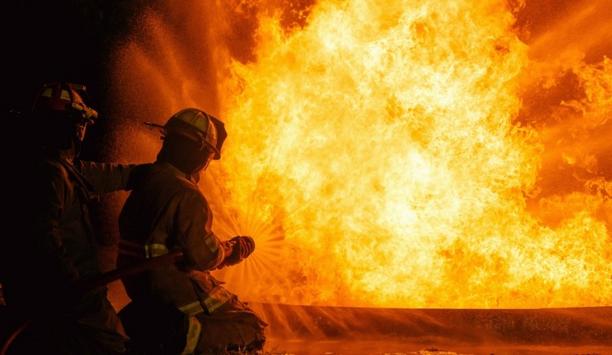
The New Future For Fire Agencies
Download
The Eight Key Trends in Fire Detection in 2023
Download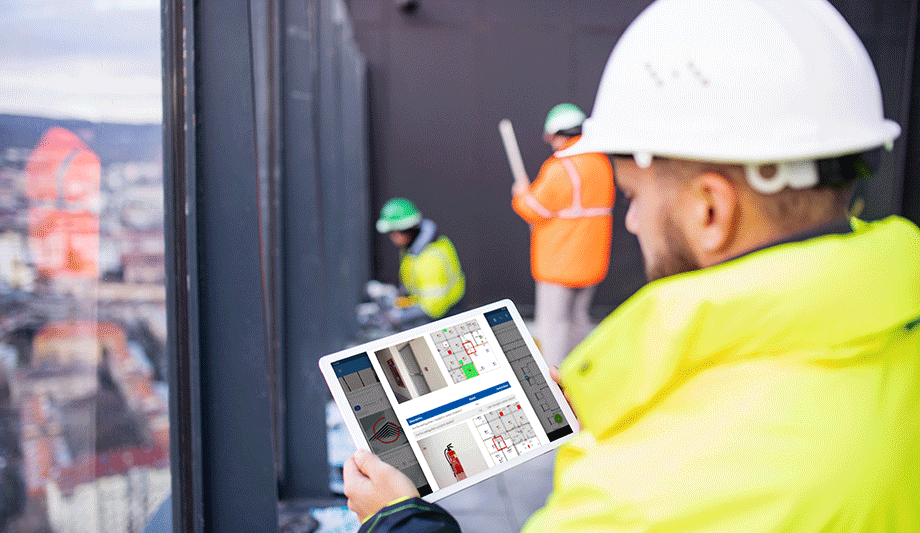
A Digital Platform to Improve Fire Safety Compliance and Inspections
Download
Overcoming the Challenges of Fire Safety in the Paper Industry
Download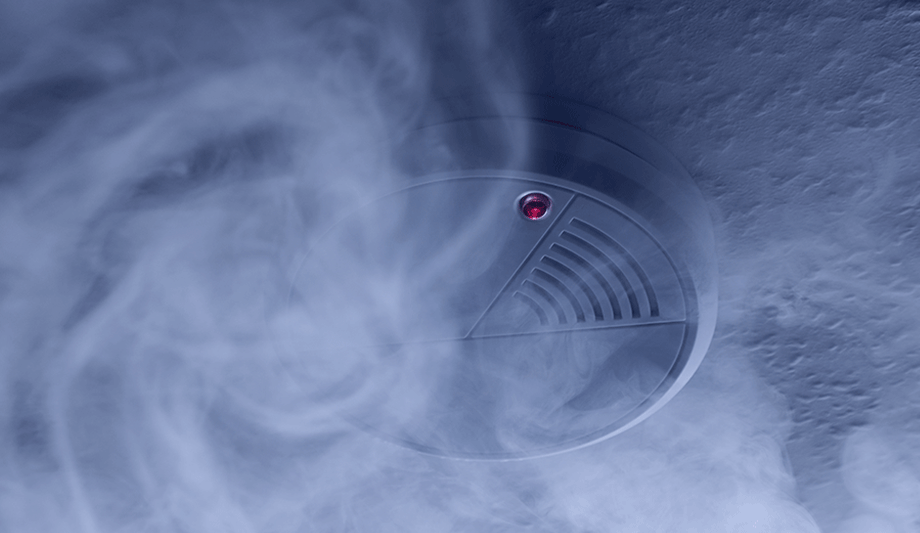
Carbon Monoxide: Creeping Killer Caught In The Act
Download

